Be Prepared for Tornado Emergencies

A Retailer’s Guide to Protecting Lives, Environment, and Property
Fred Whitford, Director, Purdue Pesticide Programs
Austin Pearson, Climatologist, Indiana State Climate Office
Andrew Pritchard, Senior Meteorologist, Nutrien
Kip Landwehr, Senior Environmental, Health and Safety Manager, Winfield
Dennis Nowaskie, Superintendent, Southwest Purdue Agricultural Center
Kevin Leigh Smith, Continuing Lecturer and Communication Specialist,
Purdue Agricultural Sciences, Education and Communication
Watching the Skies, But Ignoring the Warnings.. . . . . . . . . . . . . . . . . . . . . . . . . . . . . . 4
The Science Behind Tornadoes.. . . . . . . . . . . . . . . . . . . . . . . . . . . . . . . . . . . . . . . . . . 8
Storm Watchers and the Alerts They Issue.. . . . . . . . . . . . . . . . . . . . . . . . . . . . . . . . .14
Full-blown Emergency in Process — Your Facility Has Been Hit .. . . . . . . . . . . . . . . 24
Conclusion.. . . . . . . . . . . . . . . . . . . . . . . . . . . . . . . . . . . . . . . . . . . . . . . . . . . . . . . . ..40
Acknowledgements.. . . . . . . . . . . . . . . . . . . . . . . . . . . . . . . . . . . . . . . . . . . . . . . . . . 43
Find Out More.. . . . . . . . . . . . . . . . . . . . . . . . . . . . . . . . . . . . . . . . . . . . . . . . . . . . . . .43
Disclaimer.. . . . . . . . . . . . . . . . . . . . . . . . . . . . . . . . . . . . . . . . . . . . . . . . . . . . . . . . . .43
Watching The Skies, But Ignoring the Warnings
The following account is a composite of the many stories the authors heard while preparing this publication from retailers who experienced tornado damage.
“While driving to the retail store early one morning, I was thinking to myself about how far we were behind with fertilizer applications and burndown applications for growers so they could have a clean seed bed for planting. To make matters worse in my mind, weather forecasters had predicted rain and high winds for much of the day — two conditions that would delay us even more. And this time, unfortunately, it seemed the
forecasters got it right.
“As I looked across the fields, I saw something that I had hoped not to see — dark clouds filled the early morning sky. The wipers on the truck were already clearing the windshield of a slight drizzle, and trees were swaying back and forth from a light breeze. Every so often, I heard the noise of hail banging off the truck. I tried to keep my thoughts focused while driving into work that gloomy morning to not worry about something I could not control. Heck, what was one more day of delay added to the already two weeks I felt we were behind? “By 10 a.m., the local weather station announced that the forecast called for even more severe thunderstorms than they originally predicted. I went outside and looked out the door as a few farmers were driving into the lot. As usual, we talked about crop prices and production costs. However, much of the chatter this morning was about the day’s weather.
“By 10:30 a.m., the National Weather Service issued a tornado watch for much of the state. I, the eyewitness weatherman, peeked outside the window just to see what I could see. Cloudy, dark, and rainy, but nothing I had not seen many times before. Then, around 11 a.m., all hell broke loose when radio and television broadcasts were interrupted; our area was now under a tornado warning. A tornado had been spotted on the ground not far from our retail facility.
“We were told to immediately take shelter as the sirens in the background were blaring their ear-piercing sound. The inside staff and those working outside at the plant quickly took shelter in the basement of our main building. I hoped our employees who were delivering fuel, pesticide mini bulks, and anhydrous ammonia tanks would find shelter somewhere as well.
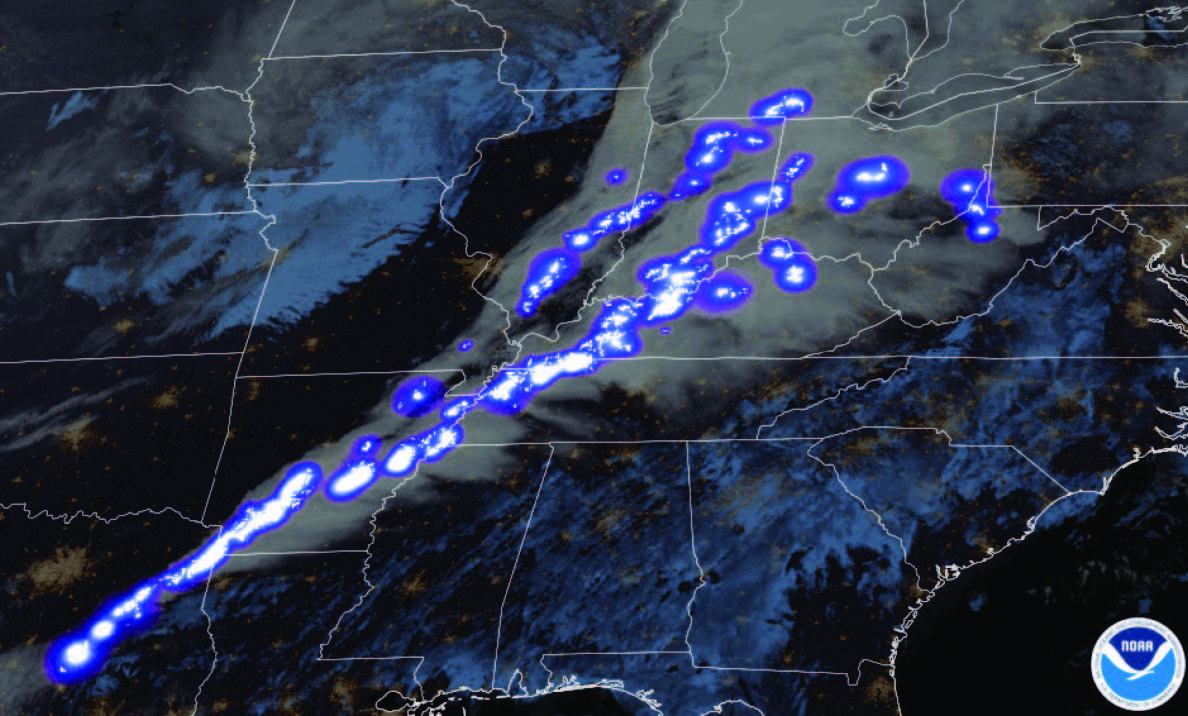
NOAA’s satellite imagery of the December 10, 2021, tornado outbreak. This information is available through the National Weather Service and your news outlets to keep up-to-date on what is happening with severe weather.
“Within minutes, we all heard what sounded like a freight train as the tornado tore across the property. The electricity went out, and as we huddled in the dark basement, we clearly heard the sound of metal roofs being peeled off and objects slamming against the buildings. Then as quickly as it had started, the loud noise turned into an eerie silence.
“As we all hunkered down together, I wondered what was happening outside as I had not put new batteries in the weather radio and our cell phones had no signals. Once the winds calmed down and the rain started to lighten, I decided to climb up the basement stairs to see what had happened. As I reached the top of the stairs, I could see daylight from the sky and rain began falling onto my face, because the roof to our building was missing.
“While the tornado had passed over the property for only a brief period, it had taken down everything in its path, including buildings, grain bins, chemical tanks, and sprayers. Everything had sustained damage, been destroyed, or simply vanished with the excessive winds. “There were overturned chemical tanks and sprayers spilling their contents, 2.5-gallon jugs and minibulks ripped open and thrown across the lot, and pallets of chemicals damaged beyond recovery. Buildings were barely standing as the force of the tornado had bent I-beams like they were plastic straws. We were left with no electricity, no phone service, and no fuel.

A confirmed tornado as the circulation touches the ground.
“To make matters worse, I had completely forgotten about all the employees who were off-site. I had no idea whether they and their families made it through the storm safely. It was complete devastation not only to our plant, but to everything in our community that was once familiar to us. What once was, was no longer! The local diners, theater, banks, grocery stores, and homes were all reduced to piles of scattered rubble.
“As the facility manager, I had to do something, but what? Where to even start? As I reflect on that day, I remember the looks of concern on all my employees’ faces as they looked to me for guidance. They would do whatever I asked of them, but I was not sure at that moment what to do first.
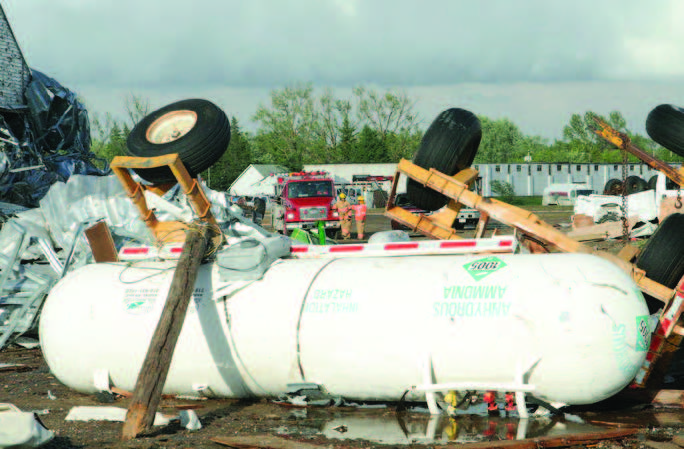
-------------------------------------------------------------------------------------------------------------------
FIND OUT MORE
Pesticides and Planning for Emergencies (Purdue Extension publication PPP-44) describes how to develop a proactive emergency plan to reduce the risk of an accident involving pesticides. Visit the Purdue Extension Education Store (edustore.purdue.edu) or Purdue Pesticide Programs (ppp.purdue.edu).
A TRUE TALE OF OPPOSITE OUTCOMES PLANNING AND PREPARATION
A particular company took a direct hit from a powerful and devastating tornado in the middle of a July afternoon. There were 140 people working there. The whole building was leveled, and nothing was left untouched. The winds were so strong that beams were found 3 miles away. Through all the destruction, not a single injury was reported. The facility had practiced their emergency response plan each year, which meant that when the time came, the employees knew what to do. The entire plant needed to be rebuilt.
UNPREPARED FOR THE EMERGENCY
A severe weather outbreak predicted days in advance was largely ignored by the facility’s personnel. When the tornado warning was issued, this facility did not have a plan in place, no designated shelter, and did not practice what to do in the event of a serious storm. After the warning was issued, chaos ensued as people were unsure of what to do and where to go. The building was totally wiped out. The lack of preparedness meant some employees lost their lives. Many others were seriously injured. Whether the results of the devastating weather have a good outcome or a tragic one are based on how prepared one is by having a plan and practicing it often enough that employees understand what to do in severe weather. By investing a little effort, your people will know what to do in the unlikely event of a tornado.
-------------------------------------------------------------------------------------------------------------------
“What I learned from this experience was that I should have asked and answered many questions long before the tornado warning. But that was of little value at this moment of looking at the destruction the tornado had done to the property.”
This manager’s plight underlines the need for an emergency tornado plan and training in the event of a severe weather emergency. Experience tells us that leaving matters to chance seldom work out in the long run, especially when you and your employees are faced with the destructive forces of a tornado and damaging high winds.
The rapid nature of a storm producing a tornado is something you cannot prevent, delay, or fight. While a tornado has a “mind” of its own, you can prepare proactively, to know exactly what reactive measures you will take to better deal with the aftereffects. This publication discusses proven strategies that can better prepare you and your employees in the unlikely event that your agricultural retail facility is in the direct path of a tornado. Specific topics we will address include:
• How a tornado forms
• Understanding the difference between a tornado watch and tornado warning
• Preparation and evasive steps to take when weather advisories are issued
• How to address the damage when a tornado hits the facility
The Science Behind Tornadoes

The United States sees an average of 1,000 recorded tornadoes each year, with an average of 80 deaths and 1,500 injuries annually. While damaging tornadoes are most common in the spring and summer as weather patterns change, tornadoes can occur all across the United States throughout the year. Mother Nature is not bound by the calendar or geographical location when it comes to tornadoes. In addition to human suffering, those same tornadoes cause billions of dollars of damage to buildings and infrastructure and disruptions to commerce. Fortunately, many tornadoes touch down outside of large, populated areas, but they still can cause costly significant damage to crops, farm buildings, and larger mature trees. The stakes are higher when a tornado touches down in a highly populated area that causes massive property destruction and increases the possibility of loss of human life.
THE DEADLY TORNADOES OF DECEMBER 10-11, 2021
Most of the weather graphics from the National Weather Service and damage photographs in this publication are from the tornadoes that swept through Arkansas, Missouri, Illinois, Tennessee, and Kentucky on the night of December 10-11, 2021. On that night, two tornadoes cut two paths along the ground — one 123 miles long and the other 250 miles — across multiple states. Eighty-nine people lost their lives, while 667 injuries were recorded. The total property damage was estimated at $4 billion.
People and businesses in the path of a hurricane may have a week or more to board up windows, move inventory to safer locations, shut down facilities, and evacuate employees. Tornadoes, on the other hand, can develop quickly and travel with tremendous speed, leaving little time to prepare once a warning has been issued. Most tornadoes are only on the ground for a minute or two, but the strongest tornadoes each year may be on the ground for as long as an hour. Tornadoes are spawned from thunderstorms. Those storms are often formed by competing air masses of cold, dry air from the north, and warm, humid air from the south. Approaching storm clouds appear dark and ominous, because they contain large amounts of rain and hail that block out light from the sun like a thick blanket. When we see dark clouds, we are, in essence, seeing a shadow. In some cases, some individuals report seeing a greenish tinge. The green skies are produced by large hailstones in the precipitation core of the storm that scatters light. While the green sheen to the approaching storm may not guarantee a tornado, it is a sign of an intense thunderstorm.

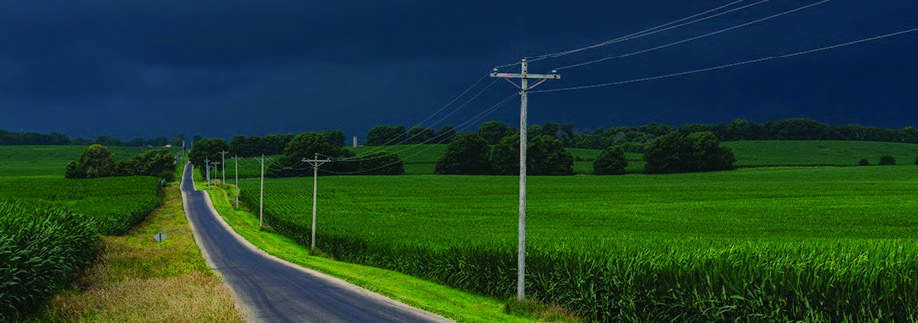
Source: The Centers for Disease Control and Prevention.
Thunderstorms are common across the Midwest. Its geographic position east of the Rocky Mountains and warm, moist air from the Gulf of Mexico provides the right ingredients for severe weather. Fast-moving jet stream winds coming over the Rocky Mountains draws a near-surface southerly flow and moisture from the Gulf of Mexico.
The jet stream, which is the river of air that flows about 35,000 feet above the Earth’s surface (where commercial airliners travel), acts as a conveyor belt that moves storm systems across the United States. Storms develop when the atmosphere is unstable (air can move upward), is moist (high humidity), and a lifting mechanism is around (most commonly a frontal system in the Midwest).
Low-pressure systems rotate counterclockwise and have both warm fronts (with warm air surging north) and cold fronts (with cold air surging south) associated with them. The low-pressure system draws humid air northward from the Gulf of Mexico, causing a collision with the cold, dry air from the north. This collision causes lift and, in most cases, allows rain and thunderstorms to develop.
Where corridors of stronger jet stream winds are found aloft, areas of lower atmospheric pressure can develop in the lowest levels of the atmosphere. The result is a complete “storm system,” with an area of low pressure, cold front, warm front, and more.
Ahead of the storm system, strong southerly winds draw warm, humid air up from the Gulf of Mexico. At the same time, cold, dry air is drawn in from the north behind the area of low pressure. The most favorable conditions for thunderstorms to develop is along frontal boundaries separating the contrasting air masses.
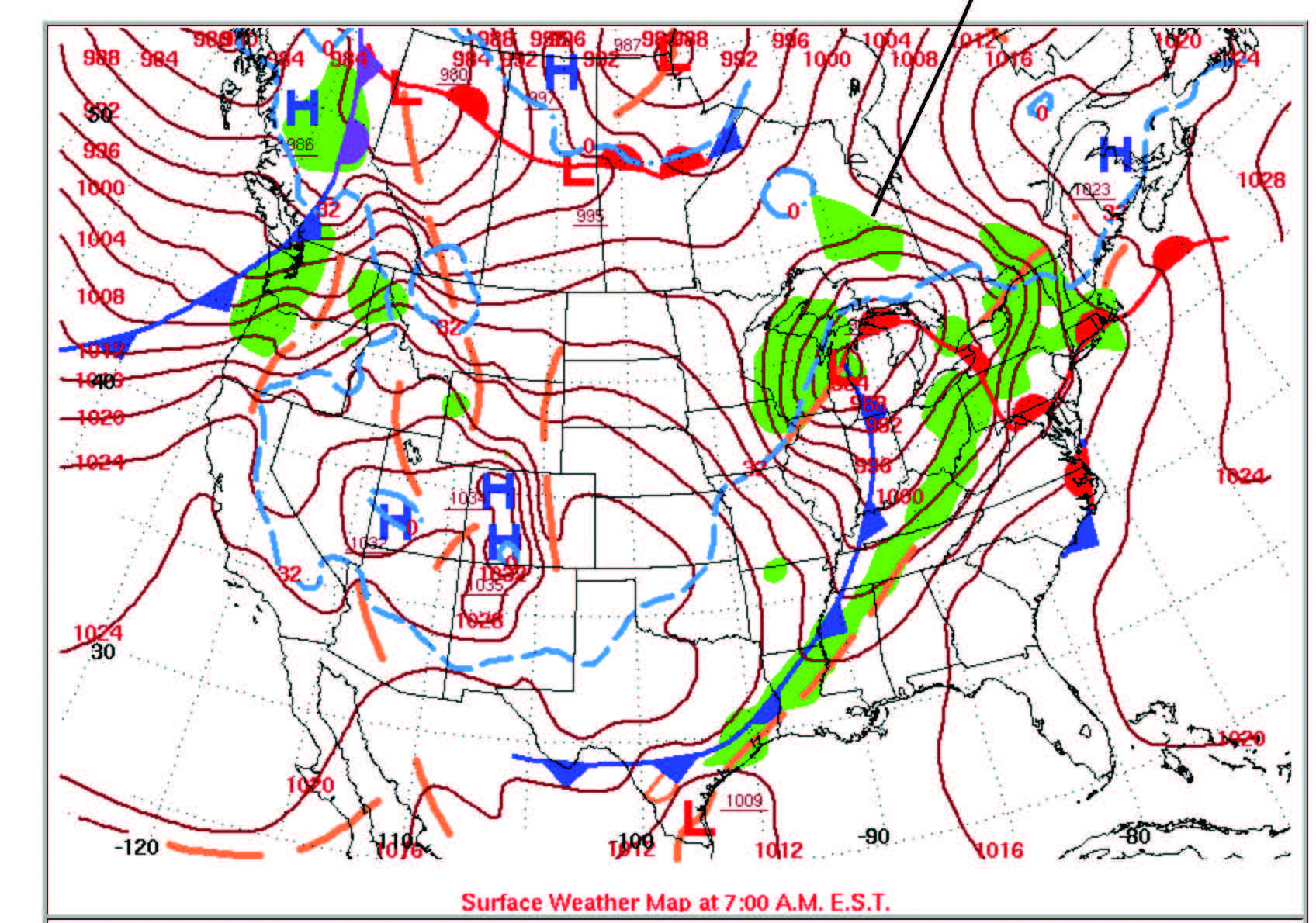
The December 11, 2021, surface weather map shows the low-pressure system (L) over Michigan and a cold front stretching southward (blue line with triangles). This was the lifting mechanism associated with the tornado outbreak in Kentucky. Source: U.S. Department of Commerce Daily Weather Maps website, www.wpc.ncep.noaa.gov/dailywxmap.
As the air masses collide, warm, moist air (being less dense than cold, dry air) is forced upward. As the warm, moist air rises, it condenses and grows into towering cumulonimbus clouds that eventually produce rain, lightning, and perhaps severe weather.
If the thunderstorm has a particularly strong updraft, suspended raindrops may freeze and accumulate ice, which become large hailstones that eventually fall from the storm once they are too big for the thunderstorm updraft to support them.
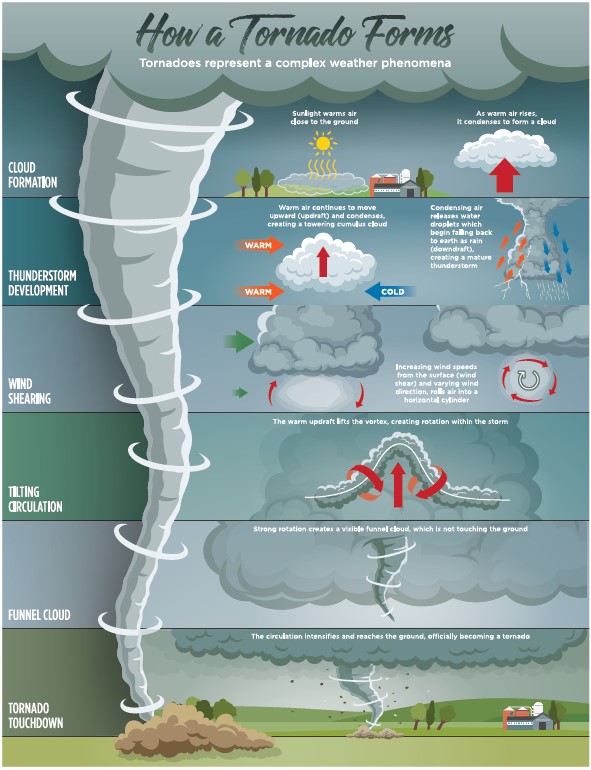
It’s one thing to develop a typical thunderstorm, but it’s another to develop a supercell thunderstorm capable of producing a tornado. Supercell thunderstorms commonly develop under the right combination of atmospheric instability, wind shear, and moisture.
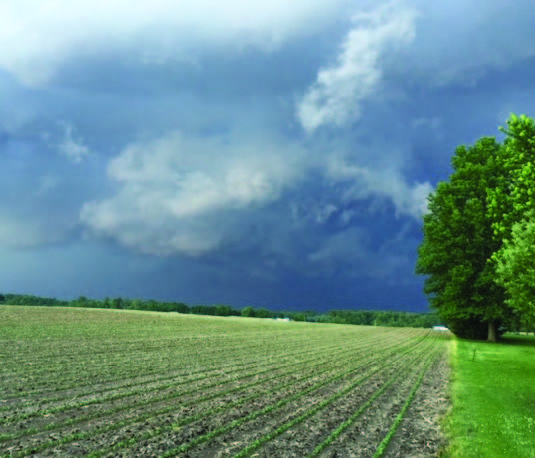
This includes specific atmospheric conditions: a warm, humid air mass; changing wind speeds from the ground upward (vertical wind shear); and varying wind directions from the ground upward (directional wind shear).
The winds changing direction and speed with height cause horizontally rotating air that is tilted upward by the storm’s updraft. The directional wind shear comes into play by creating a twisting motion with height, which can develop into a tornado. When the circulation becomes strong enough, the storm forms a tornado, which connects the cumulonimbus cloud to the ground. The clashing of contrasting air masses provides the instability that thunderstorms require to develop. The greater the contrast between these air masses is, the greater the instability, or energy available, for the thunderstorm. Wind shear is known as the changing of wind speed and/or direction with height.
These changing wind speeds and directions, if properly aligned, can create horizontal rolls in the atmosphere. When met with a rapidly rising thunderstorm updraft, those horizontal rolls are tilted into the vertical, creating a rotating thunderstorm updraft. These rotating thunderstorms are often longer-lived than the average thunderstorm and produce most of the severe weather reported across the United States each year. The majority of tornadoes are short-lived and weak. These weak tornadoes are only on the ground for a few minutes and cause only minor damage. Some tornadoes may appear to skip up and down, maintaining a sustained funnel cloud at the cloud base, but only intermittently make contact with the ground. Still, a handful of tornadoes each year may be on the ground for an hour or more and cause significant damage over a great distance.
A tornado can carry winds upward of 200 miles per hour. On average, a tornado is on the ground for about 5 minutes and will have sustained winds of about 112 mph. But during those 5 minutes, it may indiscriminately destroy anything laying in its path. Vertical winds can lift heavy objects like trucks and cars hundreds of feet above the ground, while moving lightweight materials miles from the original location.
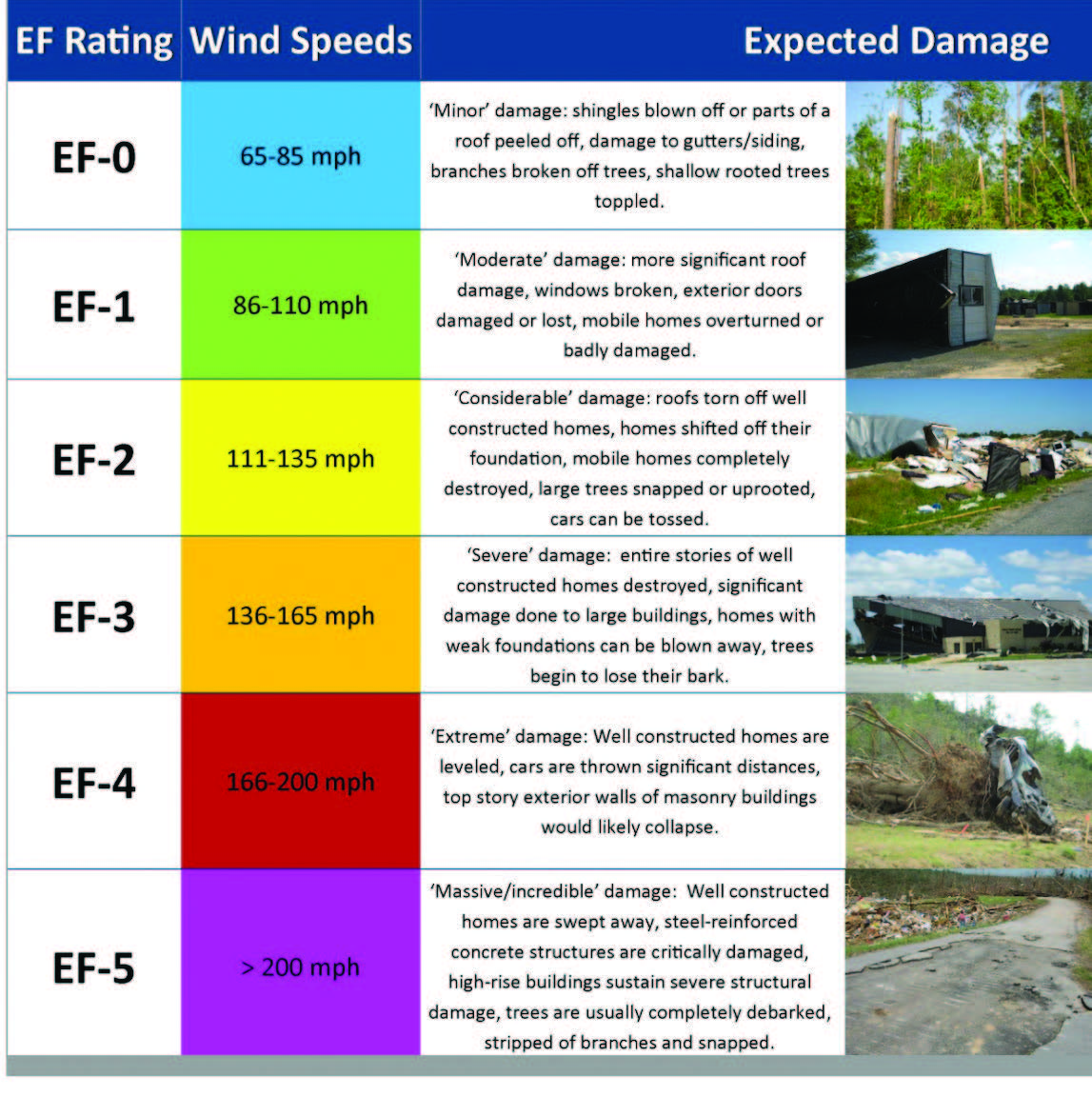
Source: National Weather Service, www.weather.gov/hun/efscale_explanation.
Some tornadoes have multiple vortices, which can be thought of as smaller tornadoes within the larger parent tornado. This tornado structure is responsible for the erratic nature of tornado damage paths such as one home being destroyed, while a neighboring home sustains little damage.
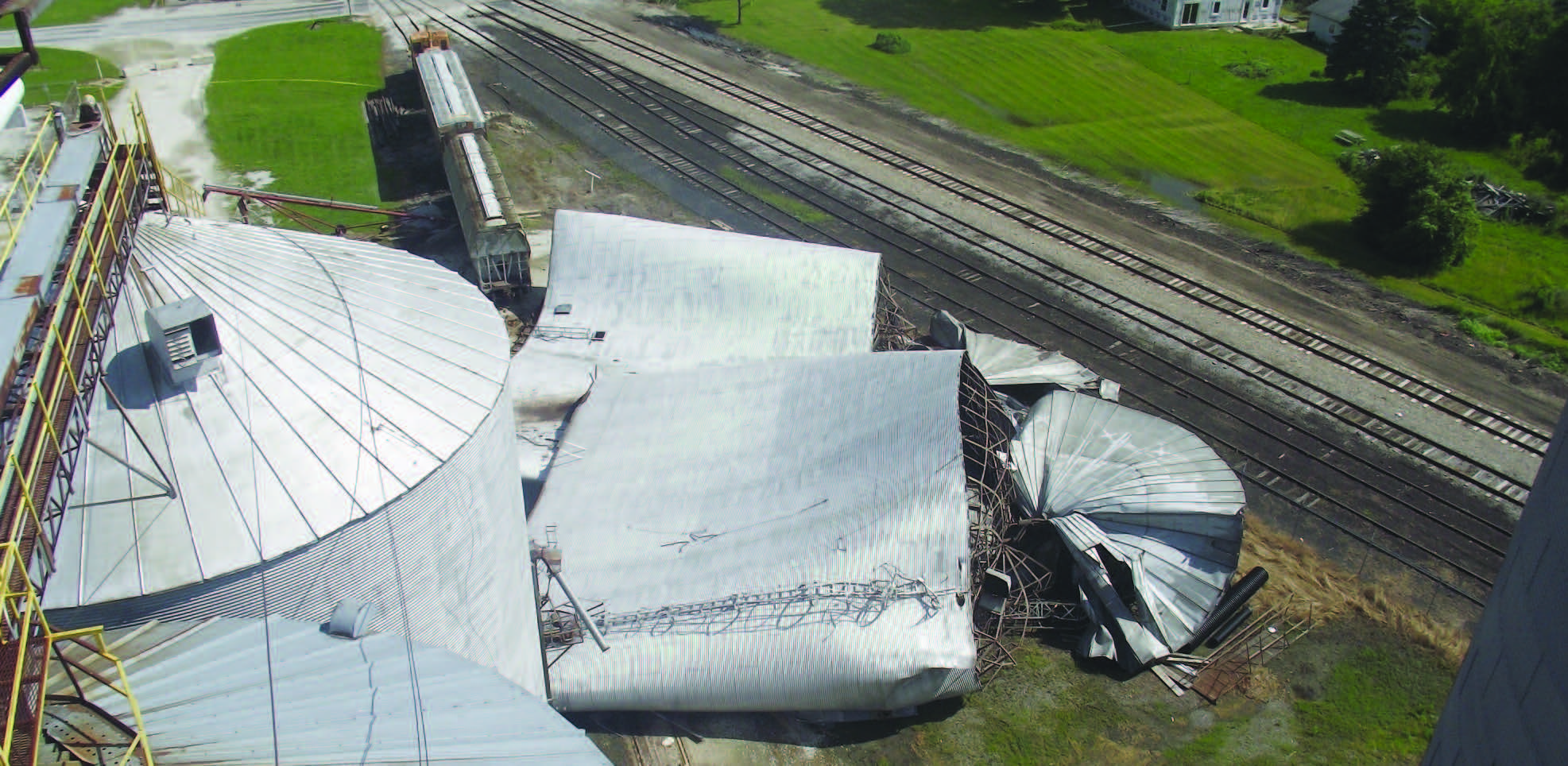
The worst damage is often associated with these small, but intense circulations within the tornado. Each year, a few tornadoes cross state borders and travel on the ground for hundreds of miles causing widespread, catastrophic damage. Tornado funnel clouds can range from several yards up to more than a mile wide. Researchers and weather specialists classify tornadoes on the Enhanced Fujita (EF) scale, which is based on the tornado’s estimated wind speed and damage potential. The EF scale has six categories: EF-0 (the weakest tornadoes) through EF-5 (the strongest tornadoes).
After storms pass, the National Weather Service (NWS) sends out teams to survey the damage and estimate wind speeds based on the observed damage. The NWS survey reports are vital first steps for determining declarations of emergency by state governors, the release of low-interest federal and state funds, and emergency housing assistance through the Federal Emergency Management Agency (FEMA).
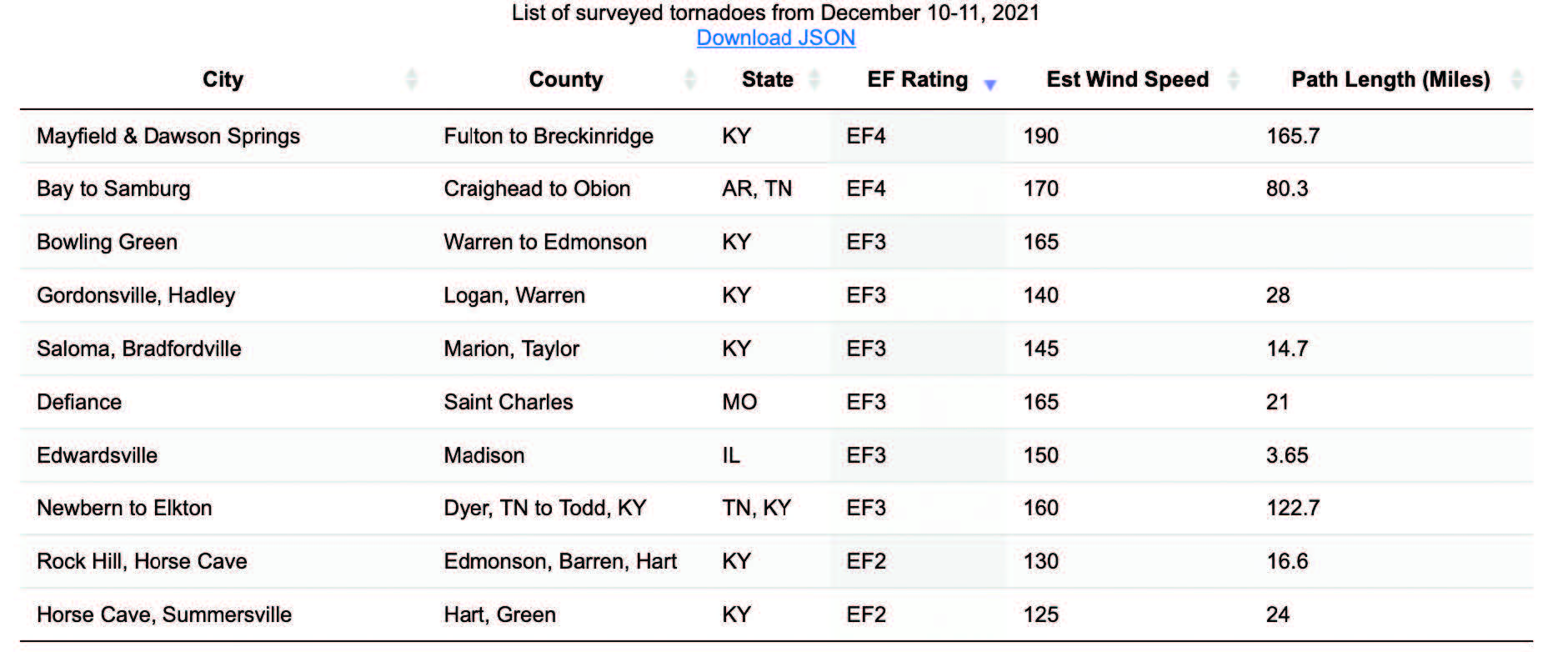
This image shows survey results from the December 10-11, 2021, tornado outbreak across Kentucky, Tennessee, Illinois, Arkansas, and Missouri. Source: National Weather Service.
Storm Watchers and the Alerts They Issue
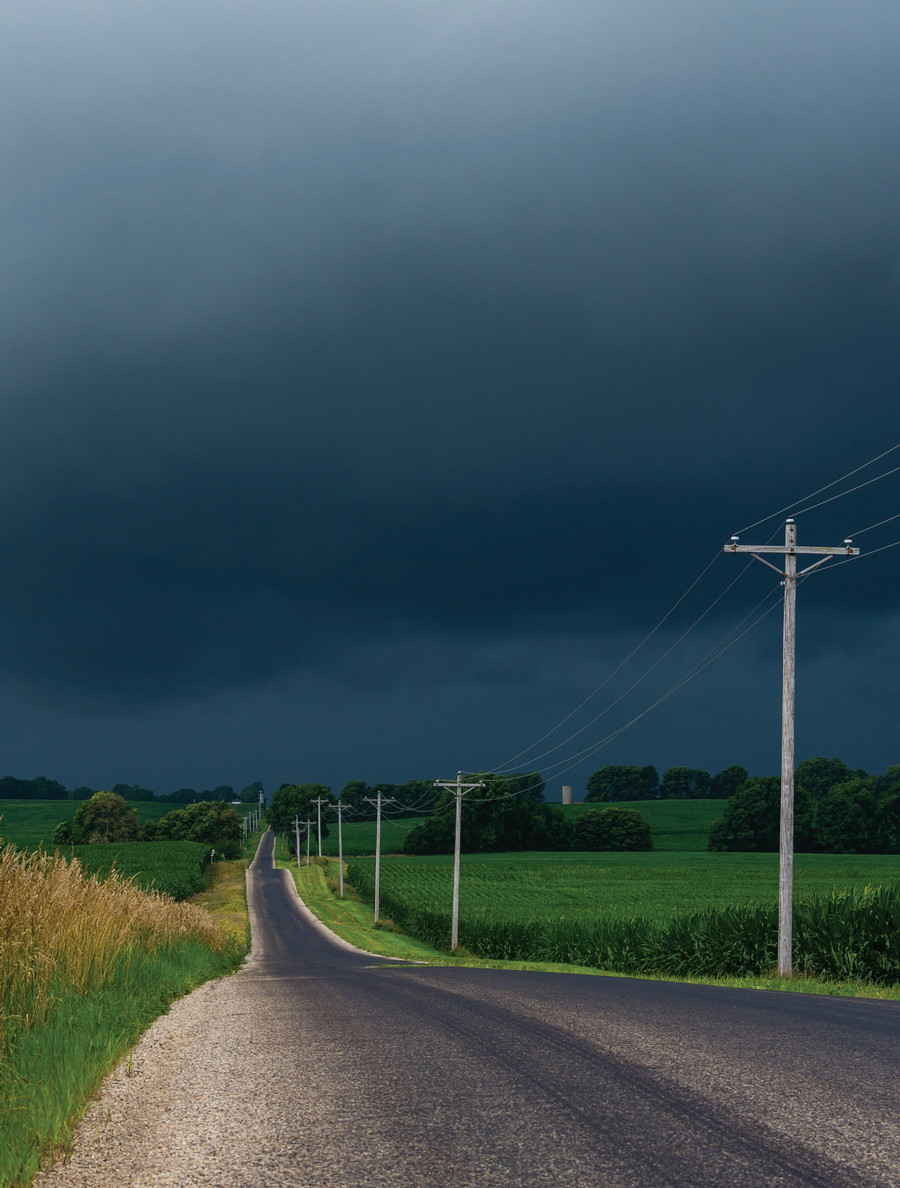
While we tend to focus our attention on local weather forecasts, meteorologists at the National Oceanic and Atmospheric Administration (NOAA) Storm Prediction Center located in Norman, Oklahoma, track thunderstorms moving across the country around the clock. These meteorologists use computer-generated weather models to constantly look for the combination of ingredients that are known to produce severe weather and spawn tornadoes.
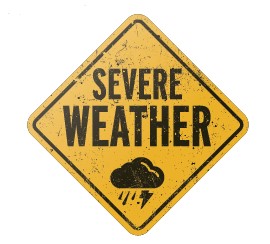
The data they use to forecast future events comes from a network of weather stations, weather balloons, ocean buoys, and satellites placed strategically across the globe. They enter the data they collect into super-computers, which then run extensive calculations based on our knowledge of the atmosphere, and then output weather forecast data. These forecasts are essentially simulations of the future behavior of the atmosphere to predict future weather conditions.
Each day, meteorologists monitor computer models with new data on the speed and direction of the jet stream and variables (such as temperature and humidity) in all layers of the atmosphere. From the computer-based predictions, they assign risk categories to the areas a storm system is traveling through make forecasts for the next eight days. The Storm Prediction Center (SPC) issues daily severe weather outlooks, which have five different risk categories: marginal, slight, enhanced, moderate, and high. The outlooks further break down individual hazards by giving forecast probabilities for tornado, wind, and hail risk. The SPC also issues daily outlooks for flood and fire weather risks.
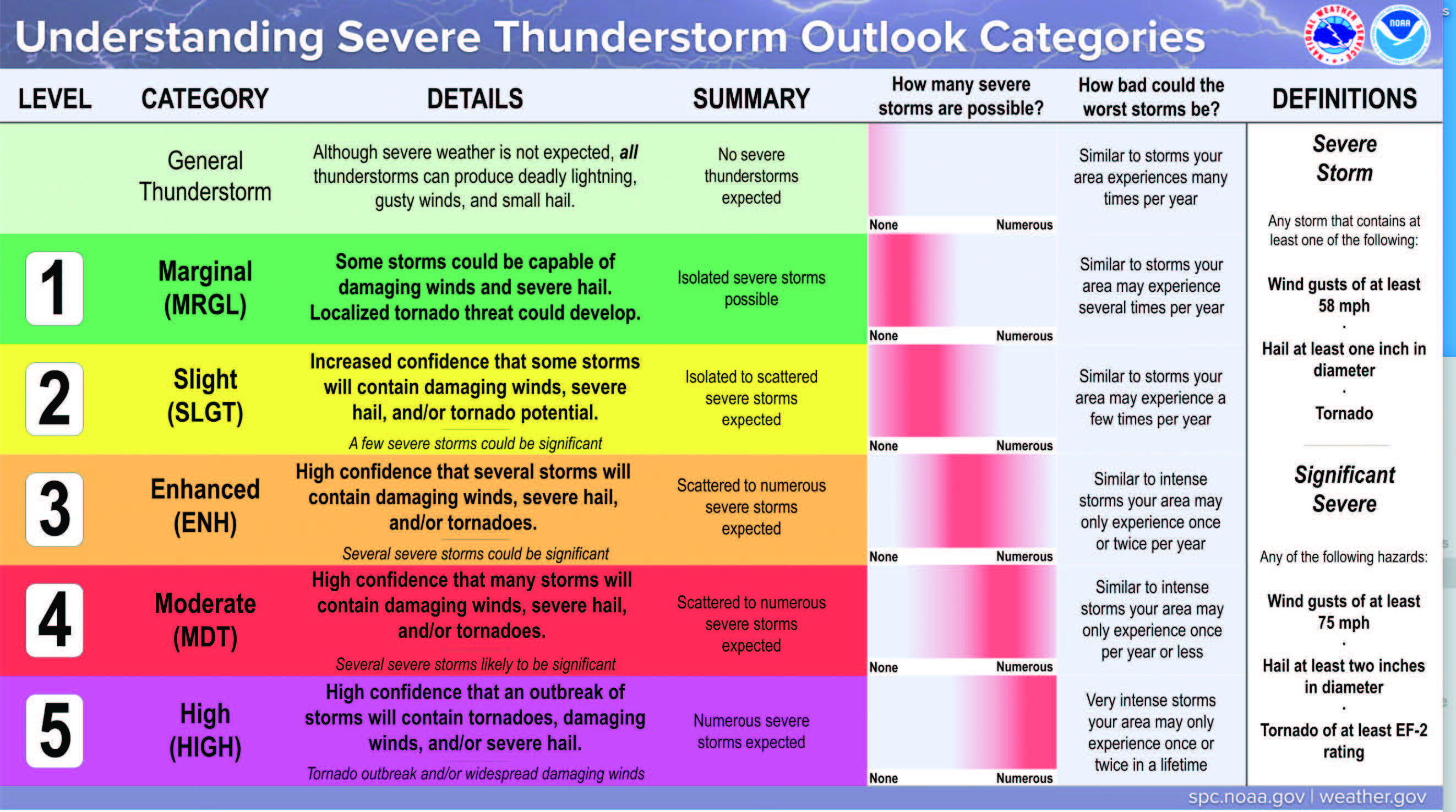
This image shows the risk categories issued by the Storm Prediction Center. It includes confidence, summary, intensity, and definitions for each category.
Source: Storm Prediction Center, spc.noaa.gov.
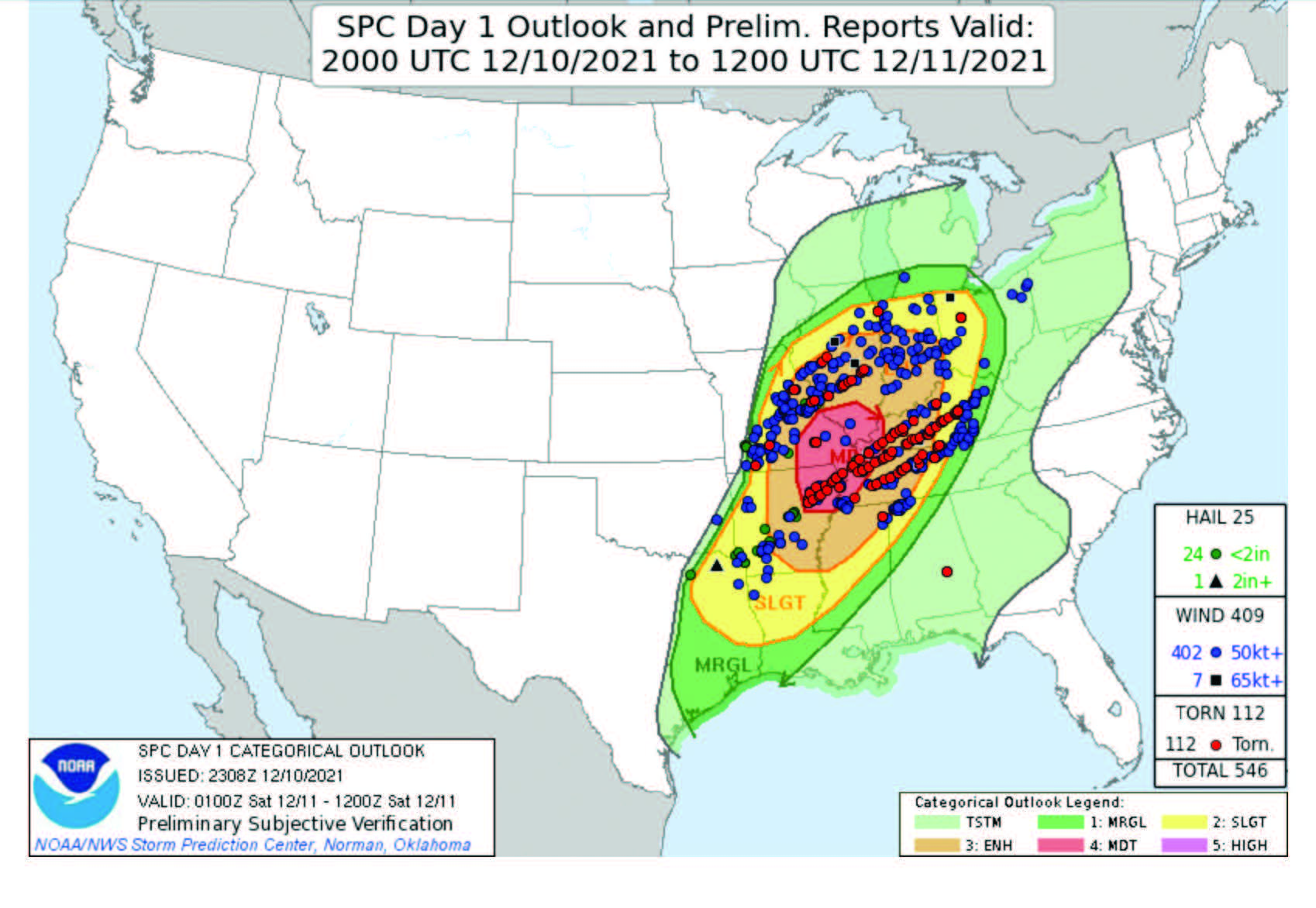
This image shows the risk categories the Storm Prediction Center issued on December 11, 2022. It includes preliminary storm reports submitted by trained storm spotters. Source: Storm Prediction Center.
Based on the data they receive, the SPC may issue a tornado watch or a tornado warning, which we will examine in more detail.
A Tornado Watch — Be on Alert

There are times when conditions change and the public needs to pay close attention to potentially dangerous situations that could harm people and property. The SPC issues severe weather watches to indicate that conditions are favorable for a particular weather event to happen, not that the severe weather phenomenon is currently happening. A watch is merely an advance notice to the public to pay attention over the next few hours to changes in weather.
There are two main watches:
1. Severe thunderstorm watch
2. Tornado watch
Authorities issue severe thunderstorm watches when conditions are favorable for one or more of the following phenomena:
• Wind gusts in excess of 58 miles per hour
• Hail of 1 inch (or more) in diameter
• Tornadoes
Authorities issue tornado watches when conditions are favorable for tornado development, not when a tornado has been spotted. Watches may cover hundreds of miles across several counties or entire states. Watches will also contain expiration times, which indicate when they predict conditions will no longer favor tornado development.
Weather watches can be found on the NWS website, weather.gov. The SPC and your local NWS offices have the ability to push watch and warning information over the Emergency Alert System, which automatically interrupts radio and television programming. Additionally, your local TV or radio stations may choose to interrupt programming with further updates.
Actions to Take During a Tornado Watch
To reiterate: A tornado watch means you need to be on alert and ready to take immediate action in the event a tornado warning — a warning means a tornado has been spotted on the ground or detected by radar. Agricultural facilities generally will not shut down operations when a watch is issued, because a watch just means conditions are favorable for a tornado to develop. If an operation were to shut down each time
a watch was issued, employees might get complacent and develop the mentality that the “Sky is falling,” which would make it more difficult to react if a real tornado appears in the area.
However, if a tornado watch is issued, you will have to use your discretion on whether work can continue as normal.
FIND OUT MORE
It is important to have all emergency information quickly available when an emergency situation arises. Quick Response Emergency Plan (Purdue Extension publication PPP-45) is a booklet helps you to keep this information readily available.
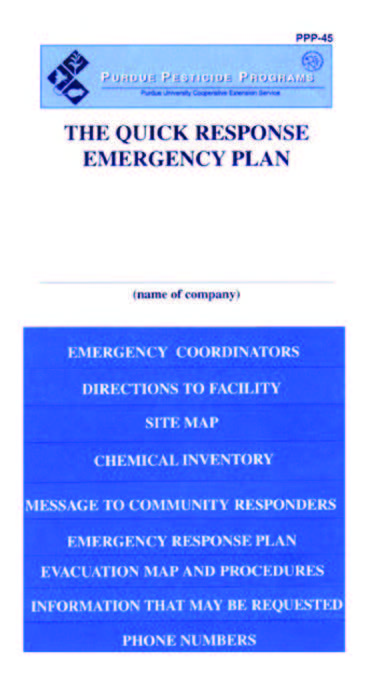
Visit the Purdue Extension Education Store (edustore.purdue.edu) or Purdue Pesticide Programs (ppp.purdue.edu).
In any case, under a tornado watch you should:
• Stay tuned to the weather advisories
• Take the watch seriously, and do not ignore it
• Not wait until the weather worsens before trying to figure out what you need to do or should have been doing already.
Taking these actions will allow you and your staff to be prepared to take immediate action if a tornado warning is issued. Consider implementing these strategies when a tornado watch is issued to help prepare for the event that the severe storm produces a tornado:
• Review the facility’s emergency response plan. Familiarize yourself with what steps will be required, what critical operations will need to be shut down, and who will need to be notified if the tornado watch turns into a tornado warning. Consider assigning a dedicated staff member to monitor weather conditions when a watch is in effect.
• Call on employees (both on-site and those out in the field) to keep an eye on the sky and quickly report if weather conditions change for the worse.
• Direct employees to secure loose debris outside. This can reduce potential flying debris with high winds.
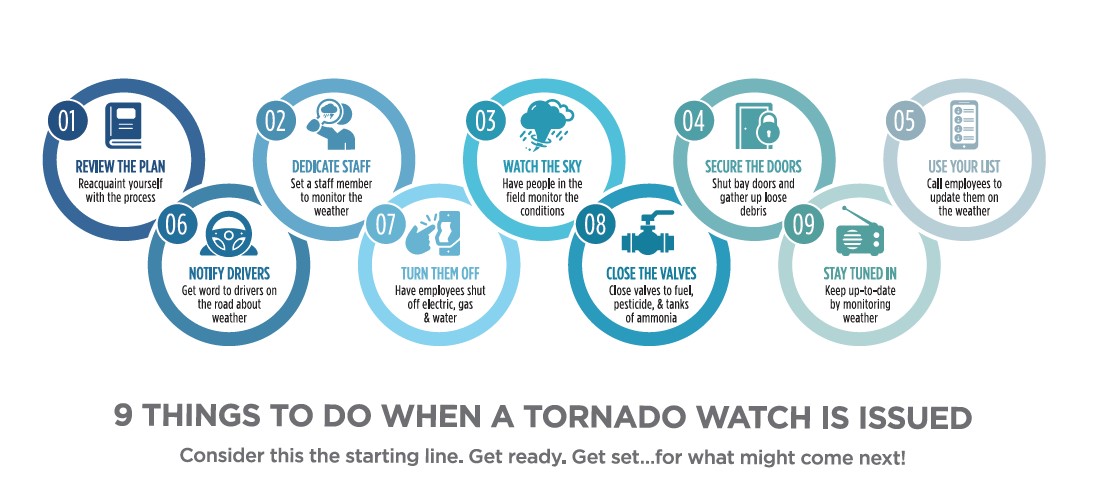
• Shut bay doors and make sure the door locks are in place. One open door may allow high winds to enter the building and compromise the structure. If time permits, place full poly tanks against the inside doors to prevent the doors from being pushed in. If possible, place sprayers and spreaders around empty poly tanks to keep them from blowing away.
• Use a text list or place calls to alert employees at the facility and those working off-site that the area is under a tornado watch.
• Warn drivers of semis, sprayers, and spreaders of any strong storms that may be approaching the area. Many companies have strict policies that drivers are not allowed access to their phones while driving. But in case of an emergency, they are instructed to pull over and answer their phone if the facility calls.
• Assign an employee (or multiple employees, if necessary) the responsibility of turning off electric panels, gas meters, and water mains. If the situation arises, make sure those employees are present and alerted that they may need to act. If employees assigned to do shut-down operations are not available, find replacements to fulfill those actions.
• Assign personnel to close valves to fuel, pesticide, liquid fertilizer, and anhydrous ammonia tanks.
• Keep up-to-date with weather changes by tuning in to local weather stations or using weather applications on smart phones. Monitor the path of the storm to determine if it is moving toward the facility. Have a battery-operated NOAA weather radio in the main office to receive critical warning information and to listen for further updates.
A Tornado Warning - Lock Down People and Property

A local NWS Weather Forecast Office (WFO) issues tornado warnings when meteorologists detect rotation on the radar or when a tornado has been confirmed by a trained storm spotter and/or local law enforcement. A WFO differs from the SPC in that they the WFO is assigned a group of counties or parishes, which allows them to watch the weather more closely at the local level. They create weather forecasts for the assigned areas and receive advance notification that a watch will be issued by the SPC.
In a severe weather outbreak, WFO personnel focus their attention on monitoring local radar, rainfall, high winds, and rotating winds within the thunderstorm to assess the potential for it to produce a tornado. These meteorologists are also in contact with trained storm spotters who are tracking the worsening weather conditions from the ground. If the radar shows rotating winds or a trained storm spotter informs the WFO that a tornado has or is developing, the NWS meteorologist will issue a tornado warning.
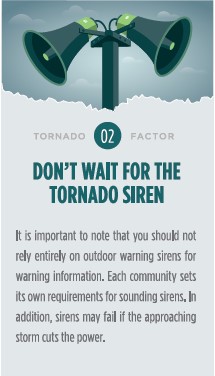
Communities often have varying policies for sounding outdoor sirens. Some sound the sirens only when a tornado has been spotted near the town. Others will activate them when a tornado warning is issued. In many cases, authorities send push notifications to smartphones to warn of the impending danger through wireless emergency alerts. The warning identifies a specific area of a county, where the storm(s) and tornado(s) are tracking and will include an ending time.
When authorities issue a tornado warning, it is a notice that the public should seek immediate shelter.
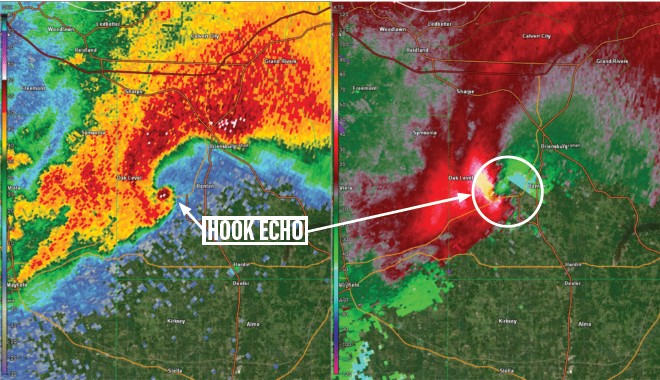
(Left) This image shows radar reflectivity from the Paducah, Kentucky, radar at 10:02 p.m. CST on December 10, 2021. It shows a classic hook echo, commonly associated with tornadoes. (Right) This image shows base velocity from the Paducah radar at the same time. The colors in the circled areas indicate the rotation (red = winds moving away from the radar, green = winds moving toward the radar). When these two colors are immediately adjacent to each other, this indicates strong rotation. Source: National Weather Service, weather.gov/pah/December-10th-11th-2021-Tornado.
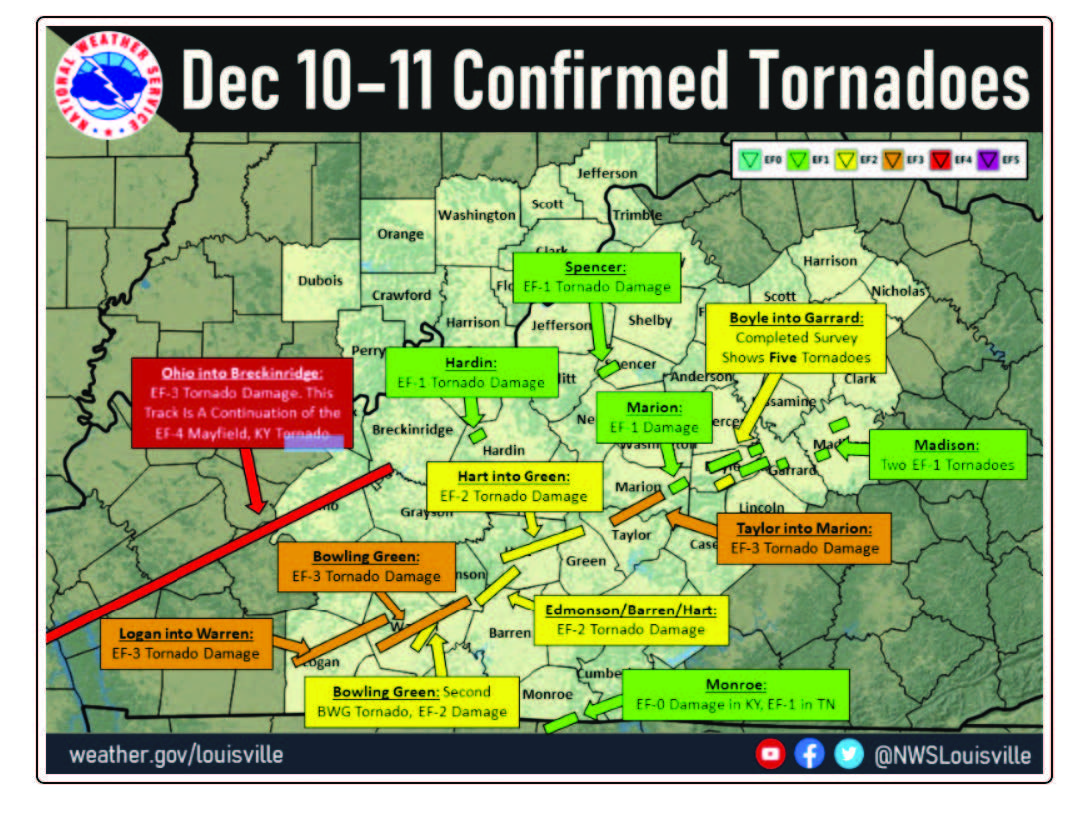
This map shows confirmed tornadoes on December 10-11, 2021. Source: National Weather Service.
Once a warning is issued, there is often very little time to react and take evasive actions. This is why we recommend that you review your emergency response plan at the time a tornado watch is issued. Waiting until the warning is issued to find and review your emergency plan will cost you valuable time when trying to decide what to do next. And worse, in a state of panic, you might be putting people’s lives at risk.
Signs of a potential tornado include dark clouds that may be rotating, debris clouds, loud roaring noises similar to a freight train or distant waterfall, and a funnel cloud. If a tornado warning is issued, it is important that you react immediately and make sure all employees seek safe shelter. It is not time to seek confirmation for yourself by looking outside — storm spotters have sighted a tornado in your area or detected by NWS meteorologists. Do not waste time trying to estimate how much time you have before heading to shelter. If the storm is traveling with a high rate of speed, you will not have time to make it to your shelter once confirming that you need to take action.

 A tornado debris cloud
A tornado debris cloud 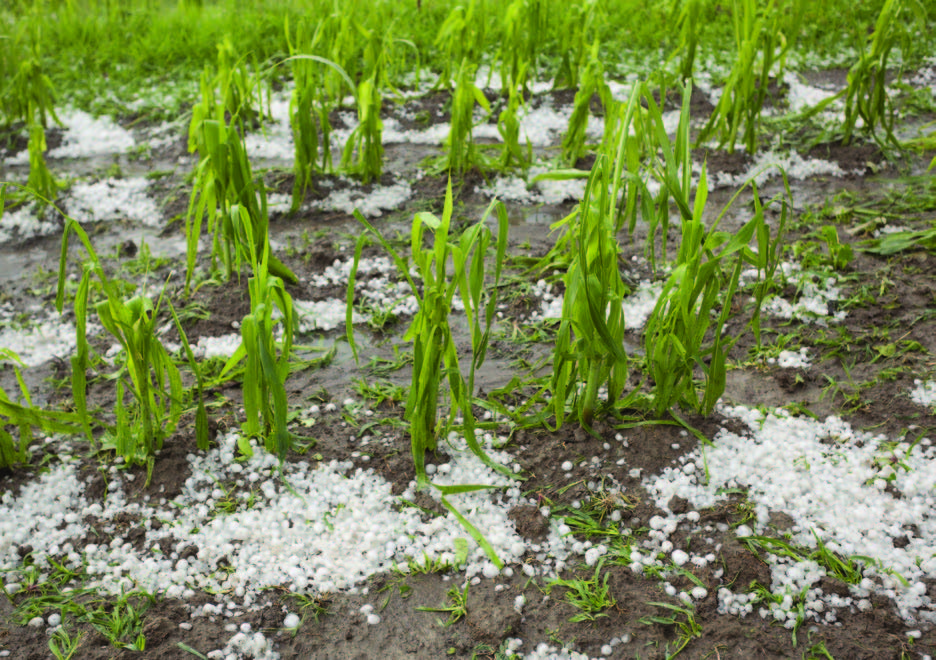 Hail
Hail 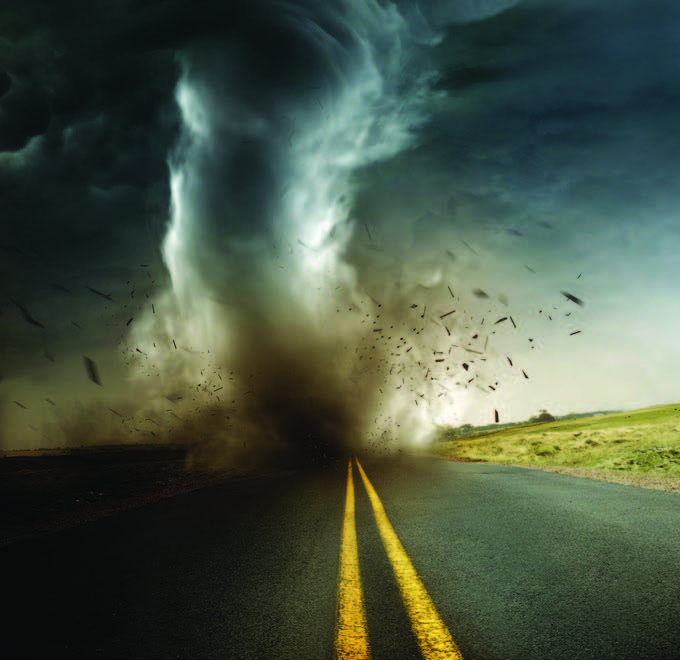 Dark clouds
Dark clouds Actions to Take During a Tornado Warning
If the weather service information indicates the tornado and storm is headed toward your facility, you should then decide to take preventative measures to protect employees, the environment, and the property from the oncoming storm.
Consider implementing these strategies when your facility is in the path of a tornado.
• Follow the protocols in your emergency response plan.
• Scale back operations to keep the rolling stock on-site until the emergency has passed.
• Protect customer billing, account information, and other financial records by backing up computers.
• Contact all employees (whether by a text message or other message) alerting them that a warning has
been issued and that the storm is tracking toward the facility. Inform them by text, phone, two-way radio, or any means necessary, to take immediate shelter. Those in the field should get out of any application equipment or vehicles to seek shelter in a nearby structure, or as a last resort, find a low-lying area such as a ditch or culvert.
• Get everybody (including those on standby) to the safe shelter.
• Have employees evacuate the facility if there is no tornado shelter on-site.

• Employees may have shelters at home, and most would probably rather be with their families at home. Inform them of the risk, but they must make their own decision whether to stay or leave. Inform them of the direction the storm is moving so if they do leave, they do not head directly into the oncoming storm or tornado.
• Except for those employees assigned responsibilities to shut down their part of the facility’s operations,
have employees, customers, and other visitors on-site get to the designated tornado shelter. That may be
having them go to the most interior room at the lowest level.

• For critical operations, utilize designated employees who are assigned responsibilities to shut down critical equipment and operations to address those needs.
• Turn off the gas main meter. A quick wrench and a 90° turn will normally work. When the meter is shut off, it will kill the pilot lights. You will need to inspect them to make sure they are working when you turn the gas back on.
• Turn off the electricity at the main breaker.
• Whether you have someone turn off the water to the facility is a personal decision. Some will leave the water supply on in order to operate sprinklers. They are concerned that chemicals will ignite.
Others indicate they anticipate the storm will bring a lot of rain, which means a fire would be less likely to occur. They turn the water off. They are also concerned that more water could cause the contamination area to broaden and cause other issues with chemicals in the building.
• Close valves and lock-out anhydrous ammonia storage tanks, gas and diesel tanks, propane tanks, and bulk pesticide tanks.
• Turn off all breakers on equipment that use power (such as mixing bays).
• Make sure to bring into the shelter a NOAA (National Oceanic and Atmospheric Administration) battery-operated radio to keep abreast of changing conditions or to tune in to the DTN network. Large-scale weather events may mean cell phone towers get jammed up or destroyed, which makes placing and receiving
calls hard or even impossible.
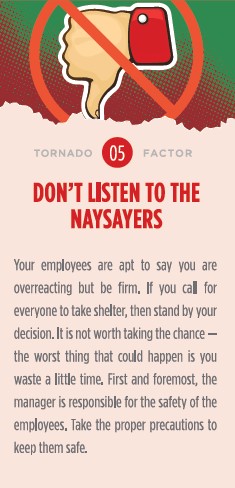
• While in the shelter, review the emergency response plan and consider the steps you might have to take after the storm passes and you can safely leave the shelter.
• Shelter in place until the tornado warning expires or the NWS cancels it. Depending on the speed of the tornado and storm, you might be in the shelter for up to one hour. Never leave the shelter until the warning is canceled or the time expired.
• When you come out of the tornado shelter, be prepared. Things might be a lot different than when you went in.


Full-blown Emergency in Process — Your Facility Has Been Hit
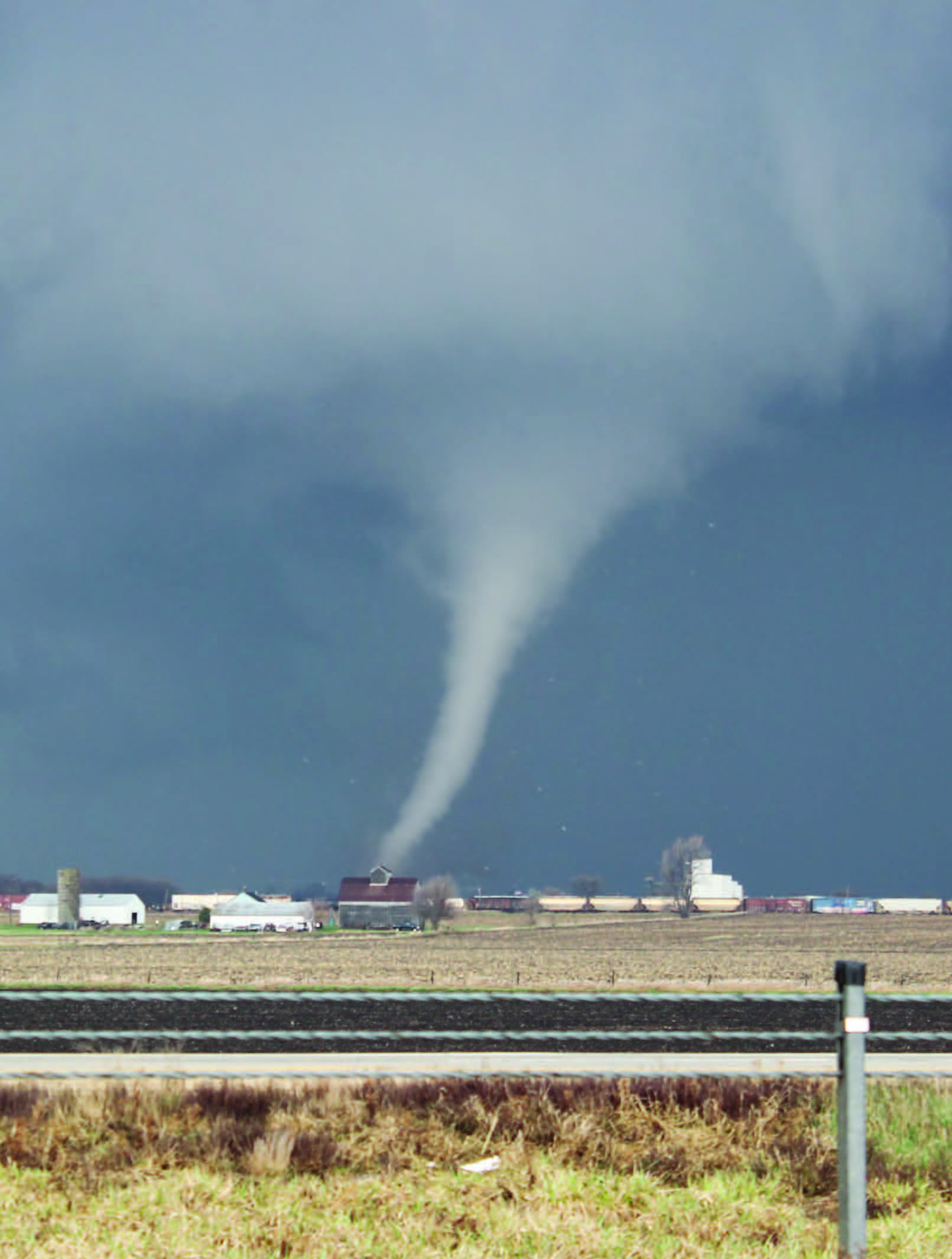
WHAT SHOULD I DO NOW?
This account is a composite of the many stories the authors heard while preparing this publication from retailers who experienced tornado damage.
“As soon as the tornado warnings expired that evening and the storm had passed, I headed from my house to the facility. As I was driving, I was secretly hoping for the best and that the storm had missed our facility. Those thoughts were quickly laid to rest when one of my employees, who lived near the facility, called to tell me there were pieces of our buildings scattered across the countryside. I told him to park at the site but do nothing until I got there.
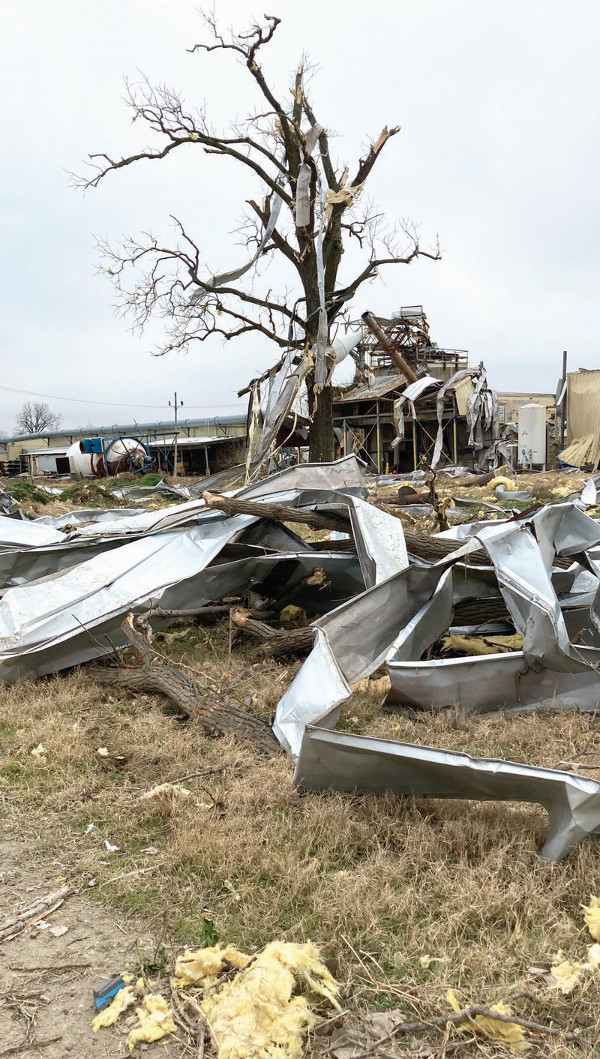
“By the time I got to the facility, it was pitch dark. The tornado had struck our main electrical pole, knocking out the power. It was still raining when I stepped out of the truck and used my truck’s headlights to get a first glimpse of the damage. I was not prepared at all for what I saw. “It was worse than I could have imagined. Trucks were flipped on their sides, buildings were partially or totally destroyed, fertilizer tanks were blown over, and busted pesticide jugs mixing their contents with the rainwater were strewn everywhere. I was in shock as I stood there in the rain observing what was left of the facility that I had managed for 20 years. In that moment, the only thing
I could think was, ‘What am I supposed to do now?’”
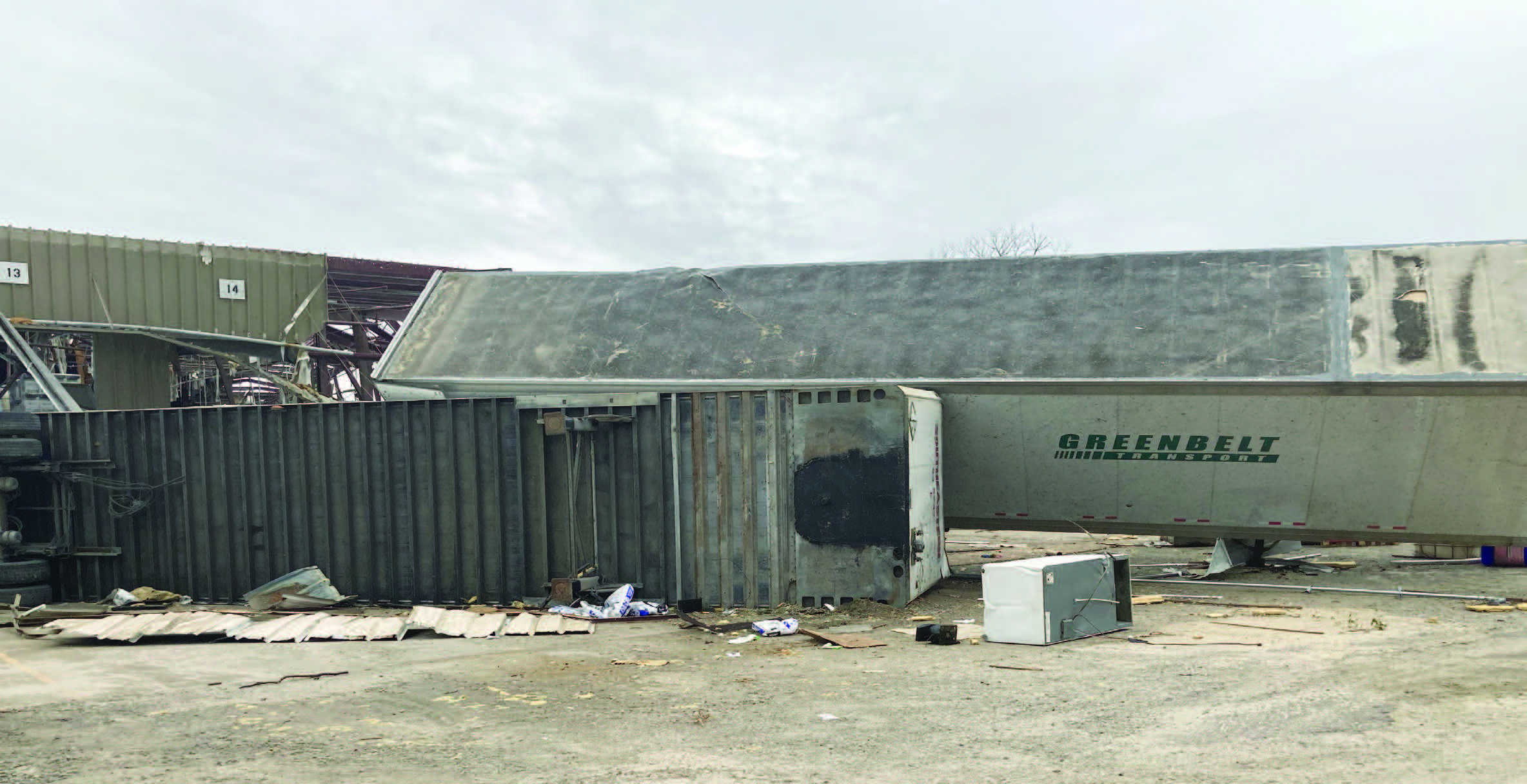
A great deal of emergency response training, while helpful and necessary, seems irrelevant when a tornado levels an agricultural retailer’s facility. Much of that training focuses on handling much smaller and more localized releases — dealing with a shuttle leak, punctured products on a pallet, leaks from a fertilizer mild steel tank, leaking spray equipment, or overturned anhydrous wagons on the roadside. These are discreet emergencies that employees are well trained to handle. This is not meant to downplay the importance of those emergencies, but the damage from a tornado is in a league of its own.
The Focus on the Retail Manager
In most instances, plant managers handle the day-to-day issues and responses to rectify problems. Plant managers also are used to being responsible for employees, products, and customers. But now, due to the fact a tornado has razed the site, the responsibility is intensified and includes the added burden of figuring out how to clean up the mess left from the tornado. That mess includes many aspects. There are damaged structures and equipment, of course. But one of the most important problems to address after a disaster is accounting for and cleaning up after any chemical products at the facility. You don’t want an environmental disaster of an unchecked chemical spill to follow the natural disaster of the tornado.

An obvious question that every manager faces with this dilemma is: “Where do I start when it looks like someone set off a bomb in the middle of the plant?”
The first step is to take a deep breath, organize your thoughts, and follow your emergency response plan. Trust your instincts and working knowledge of the facility to get you through the stress of handling so many problems in such a small amount of time. Don’t second guess yourself even when you find yourself in the middle of chaos. Handling matters during those first hours and days after a storm will put you in the best position to answer questions and make decisions. And don’t worry if, after the fact, people who were not even at the site say that they would have done things differently. Only you know what was happening at ground zero.
Think Today About What Might Be
There is no, one-size-fits-all standard operating procedure for what to do when a tornado turns your world upside down. There are obviously different opinions and approaches based on the severity of the contact, but you will be the one calling the shots until others arrive to offer their expertise, opinions, and/or approvals to move forward. There are several general steps to follow from the time you first get to the site until the plant is up and fully operational again. These steps can last for weeks, months, or even years depending on the severity of damage.
The steps generally fall into three categories:
• Disaster response — the immediate reaction (steps 1-2 below)
• Recovery response — the cleanup (steps 3-9)
• Customer response — meeting their needs (step 10)
After this begins the rebuilding phase.
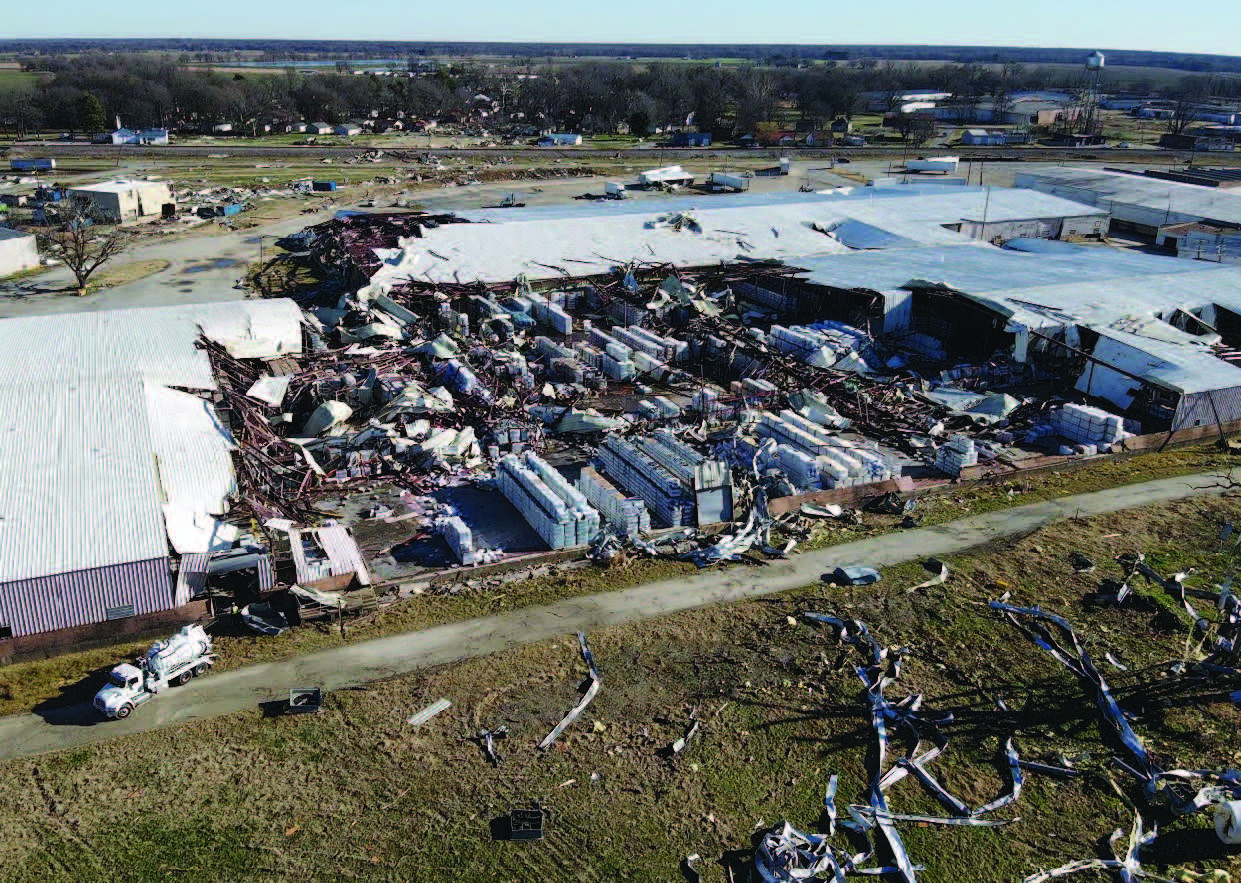
Step 1. Protect Employees and Contractors from Start to Finish
There may be little you can do when a tornado hits in the middle of the night. Rushing to the facility when it is pitch black serves no purpose other than to put people in a precarious position. Always wait until you have enough daylight to evaluate the degree of damage unless you are absolutely sure that your defensive actions will cause no harm.

After you get your initial bearing of what happened, check the weather. If more severe weather is on the way, that could alter your first actions. It doesn’t make sense to bring resources and people to the facility if a second round of bad weather is approaching. This second storm system could bring down buildings that were left barely standing from the tornado and could finish knocking down leaning tanks.
As you start the evaluation process, keep everyone out of compromised structures until a qualified structural engineer inspects them. Use construction or barrier tape to seal off these areas and make sure that everyone is aware of the dangers posed by entering damaged buildings.
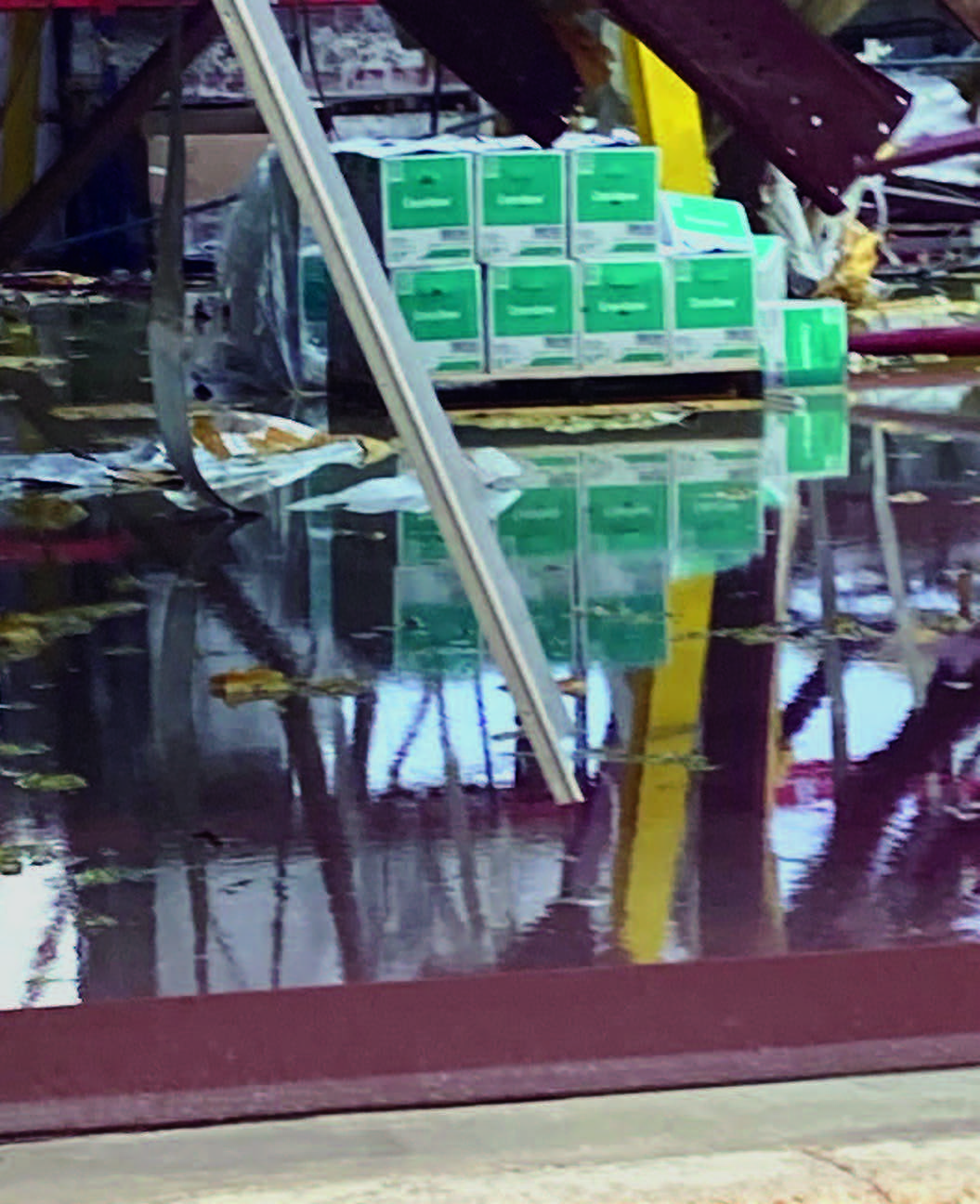
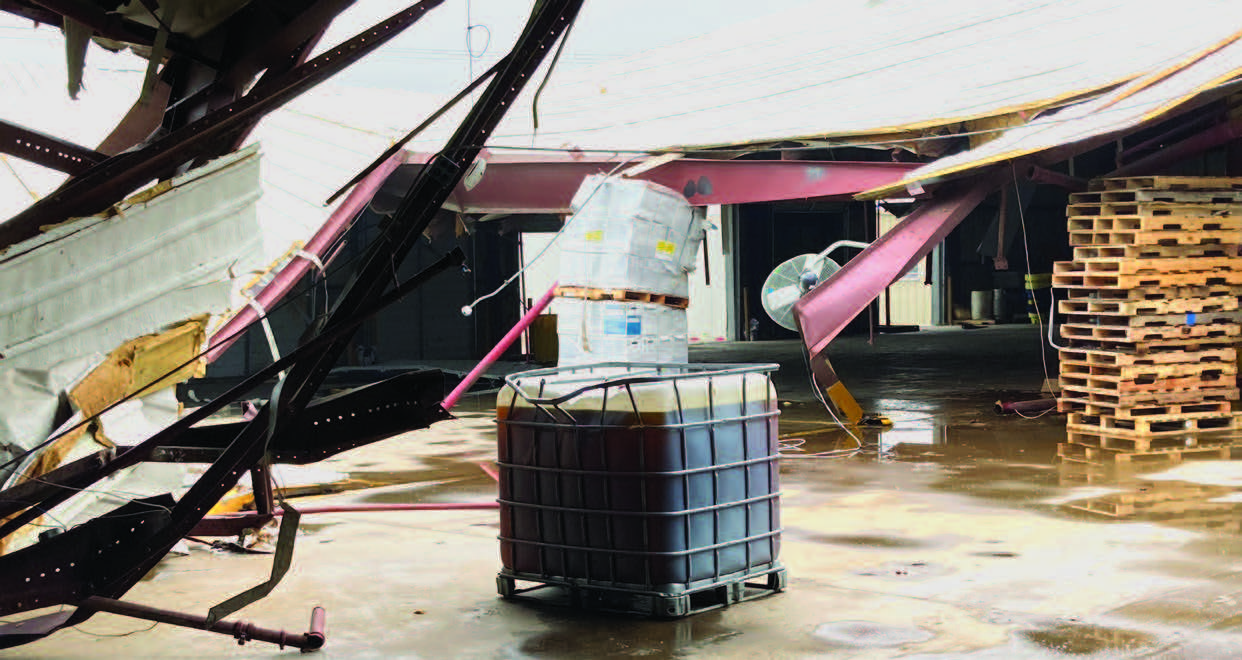
Until you have an idea of how bad things actually are, the best you can do is to implement defensive actions. Not to be repetitive, but do not make a bad situation worse by exposing employees to dangerous situations. For instance, several employees tell you that they smell gas, all people (including the employees of any contractors working on-site) should be evacuated off-site until the gas leak is found and is repaired.
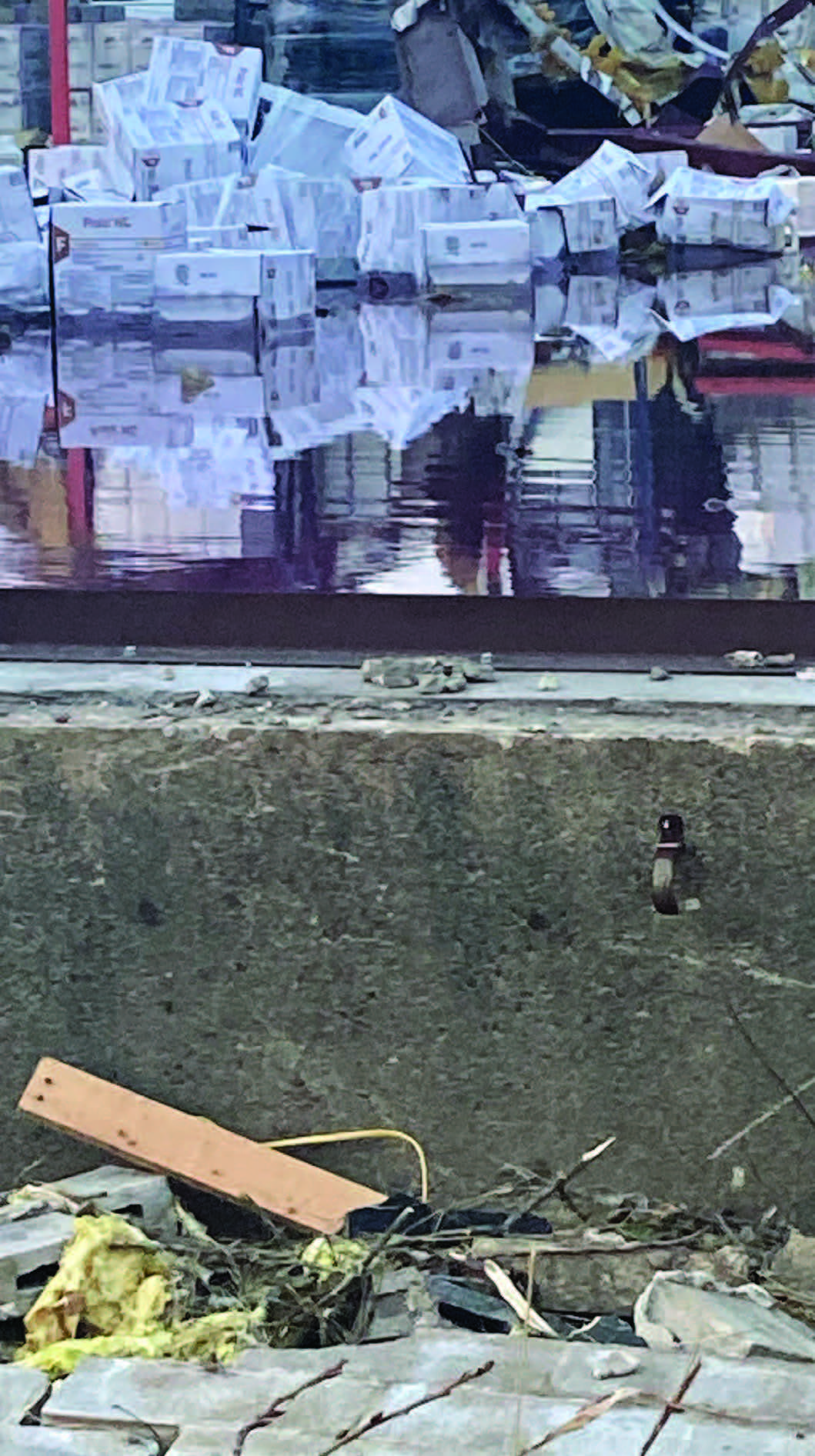
Remember to be patient. Although you may want things to be back to normal ASAP, being impatient and panicking will help no one. Utility companies may be slow to answer because they might be dealing with multiple power outages and gas leaks over a widespread area, or they may be unable to reach your location because of debris blocking the main roads.
Step 2. Implement Defensive Measures to Keep the Problem on the Facility
Your next actions should be to prioritize the work and minimize the impact of whatever is happening that could affect the plant’s perimeter. If you have a full 30,000-gallon tank sitting on its side, but it is not leaking, that should be a lower priority than damaged chemical products that are mixing with rainwater and running down the side of the exposed building.
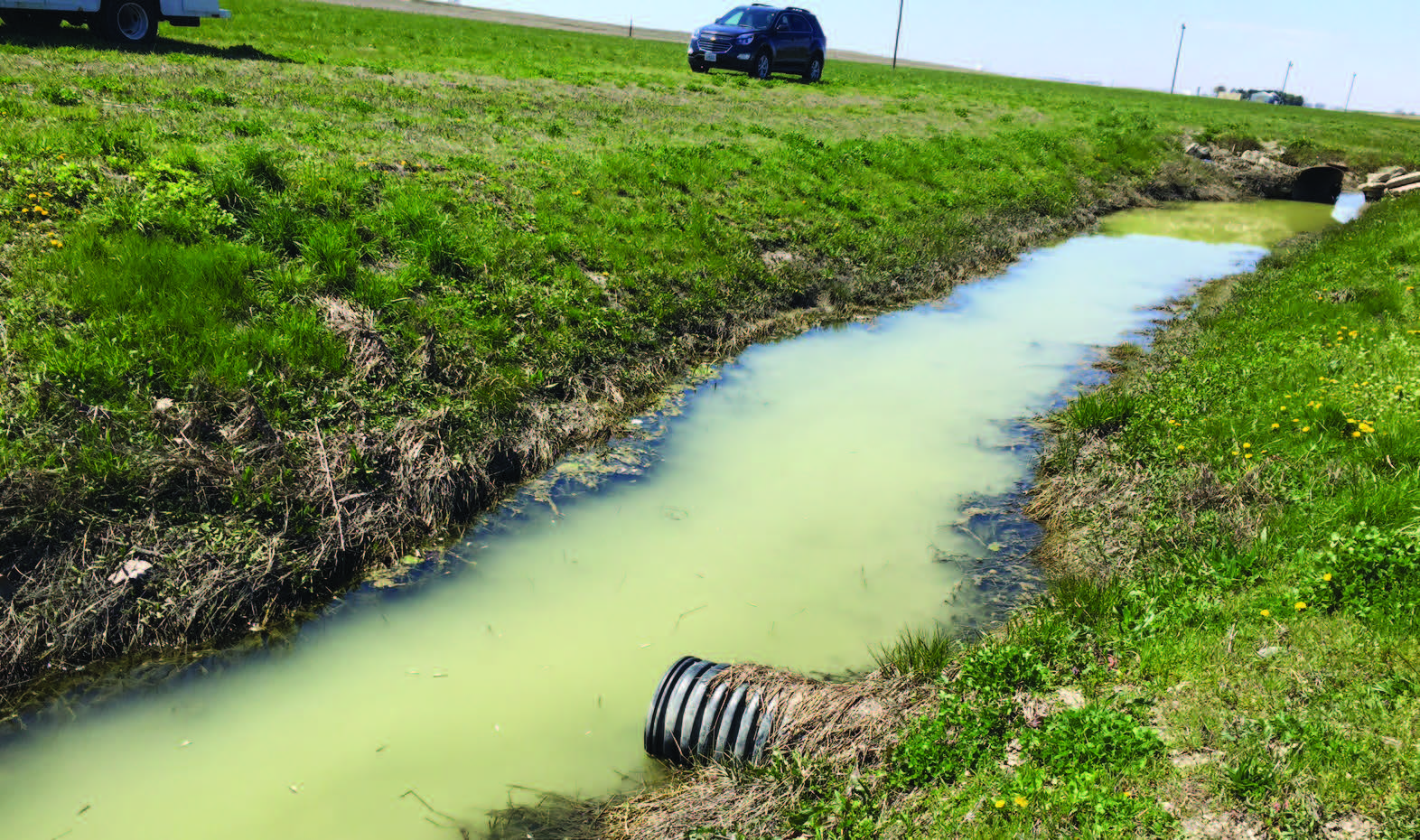

Building temporary dams is one way of containing the material on-site.
It is important to keep everything you can see on-site. The first actions to limit off-site environmental damage could include:
• Turning off the water
• Plugging drains leading off-site
• Closing tank valves
• Emptying leaking tanks
• Building berms around leaky containers
• Flipping overturned vehicles right side up
• Damming a creek
If you can contain any contamination on-site, you have won the first and most difficult battle of the war.
Step 3. Make the Calls to Bring in Expertise and Assistance
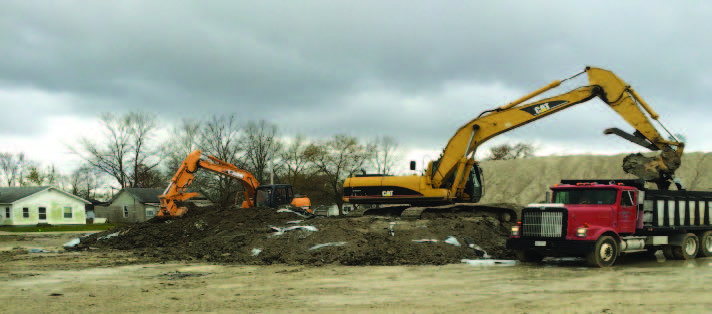
One of the more critical things you can do as the manager is to contact the individuals listed in the emergency action plan. Although, you may wonder why calling those holding positions in procurement, marketing, risk management, or the chief financial officer, and the chief executive officer can help you with the problem at hand, the simple answer is they will begin the process of getting resources rolling to you as quickly as possible.
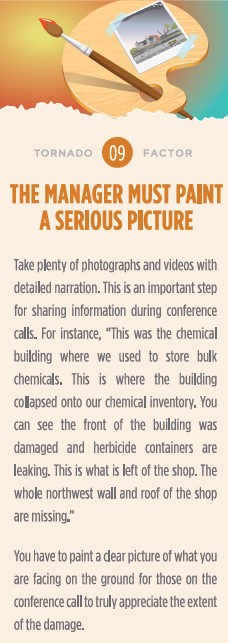
They can assist with or take the lead on contacting others to get resources, materials, supplies, and workers to your site to help with the remediation and recovery process. Those resources might include generators, water, equipment, sand, and whatever else you need. Getting this help allows you to focus your attention spotting and controlling high-priority issues. Those responsible for financing the recovery response will need to be informed on the progress you are making, because large amounts of money may be required. The financing people will have to appreciate the state of emergency and that the normal procedures of possibly acquiring three bids and waiting for a week (or more) for decisions, will not work. Traditional procedures for acquiring products and supplies will have to be bypassed to expedite bringing materials to the site as quickly as possible. It may also be necessary to extend credit card limits to allow for immediate purchases.
If the problem at the site is severe enough, it could help if those who are critical to the recovery process come to the site. Having them on-site in real time provides you with their opinions and expert advice until you stabilize the site. It makes dealing with the problem so much easier than playing phone tag and waiting for calls to be returned. The time you spend on the phone is less time you can devote to dealing with crews trying to get the work done.
Calls to Third-Party Emergency Contractors. We may be good at managing our ag retail and product distribution facilities, but the typical agricultural industry workforce does not have the skills, training, or equipment needed to remediate a site hit by a tornado. Calling your company’s emergency contractor can bring much-needed experience in these critical areas.
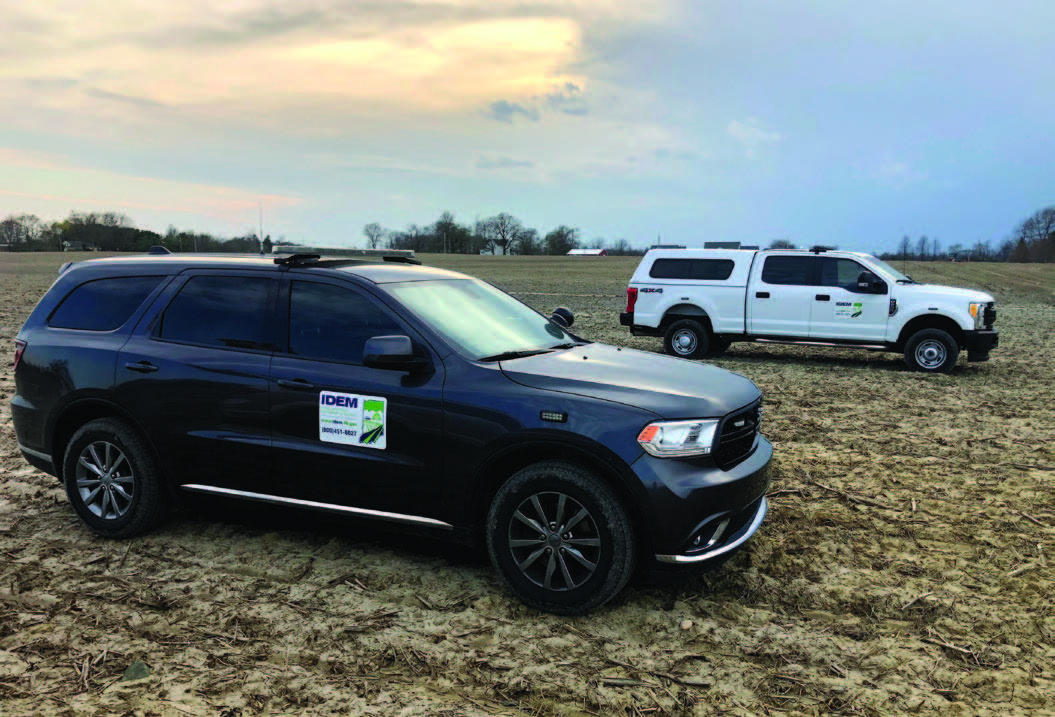
Calls to Regional Managers. Regional operations managers can often deploy personnel, forklifts, and semi-trucks from the company’s branches to help with the cleanup. Calls to State and Federal Agencies to Report Spills. Federal and state laws require you to report spills (at some level of release) to a specific agency. Depending on the severity and quantity that was potentially spilled, you will need to make those initial phone calls. Most of the time, your call may be just a heads-up to the agency: “We had a tornado and have damage, but we do not yet know the extent of what was spilled. We will call you back when we have more information to report.” Getting that call in early is extremely important, because it shows you reported the incident in a timely fashion. Under most jurisdictions, those making the initial report will be asked to make a final report of how the situation was handled and what was done to mediate or clean up the site.
Expect state agencies to ask for your plan. If you do not have a plan, there is a good chance the state agencies might handle your situation differently. They might feel compelled to camp out at your facility, because they might be concerned you don’t know how to address the problem.
Make sure to let them know what you have done, including:
• Make them aware you have a copy of the emergency response plan in your possession and have established a response team to remediate off-site impacts.
• Describe initial steps you have taken. For example, let them know you blocked all drains to stop water from leaving the site.
• Inform them who will address any spills and perform the assessment. Also, let them know how quickly those individuals will be on-site. Working with a third-party emergency contractor gives the state the sense that you have planned for an emergency and have a professional team responding to the situation.
• Review who you have contacted. Letting authorities know that you have already communicated with your Local Emergency Planning Committee, local fire department, and others which shows you are actively seeking outside support (whether it is available or not).
• Have an inventory of what chemicals are on-site.
• Inform them that you have identified the chemicals and have access to the SDS sheets for each of the products that were released. You should have a backup system in another office or on a computer that is in a remote location.
Whether the state agencies responsible for spill response appear at your facility depends largely on the extent of the off-site damage. If you are able to contain the impact on-site and your problems are more structural, they may deal with your company over the phone. If the spill happens to get to a nearby waterway, you should expect an official agency visit.
If any agency visits your site, the first thing you should do is ask to see the representative officials’ credentials and have them sign in. Second, take them to the conference room or somewhere (possibly an off-site safe meeting space close by) where you can have a meeting and do a quick dig for information — Why are they there? What are they looking for?
Additionally, you would want to inform them that this is an active investigation and cleanup, and you are working to gather all the details. Assuming the threat to the environment is minimal and your facility has a team or third-party responding to clean things up, they may simply ask for progress reports. If there has been an uncontrolled release from the site, the agency may decide that there is a threat to the environment or public safety. In such cases, they might insist that someone from their agency become part of the emergency response effort. If this happens, they probably will expect to attend all daily (or more frequent) briefings, walk the site, sample where and when they want, take pictures, and critique any contractors’ work and overall emergency response efforts. However, they must follow all safety protocols that you have in place.
Remember, if a state agency is present on-site, expect the media to follow. You may have to schedule daily briefings with the media and community for large emergency situations.
Calls to Insurance Companies. Your risk management contact person will call insurance companies because they could be asked to pay for a large portion of the remediation and rebuilding expenses. Depending on policy and the coverage limits, different insurance companies may provide coverage for inventory, building, and environmental cleanups. In many cases, the retailer may be self-insured up to a certain amount. The insurance companies will send out adjusters who will expect a full walkaround of the facility to inspect the damage for themselves. Adjusters will evaluate what has been done, talk to third-party remediation contractors, and ask what your next actions will be. Your answers will give them a certain comfort level and allow them to trust that you know what you are doing.
The one thing to remember with insurance companies is they are not an open checkbook. Most likely, they will scrutinize any and all bills they receive and ask a lot of questions on the back end after the facility is up and running. Contractors need to understand up-front that you need them to provide you with a level of detail on each bill they submit for payment. Try to get a weekly billing to make sure the charges they are submitting will meet the insurance company’s scrutiny. It is nearly impossible to recreate this level of detail on the back end of the project. Remember to also track the hours and benefits of any employees who might be coming to help. Insurance policies may cover these expenses.
Calls to Obtain Materials for Workers. The workers involved in the cleanup may require on-site portable bathrooms, drinking and washing water, Tyvek suits, gloves, 24-hour security, large boxes, drums, printing labels, oil dry, emergency lighting, and much more. Be sure to call those who can provide these materials as soon as you can.

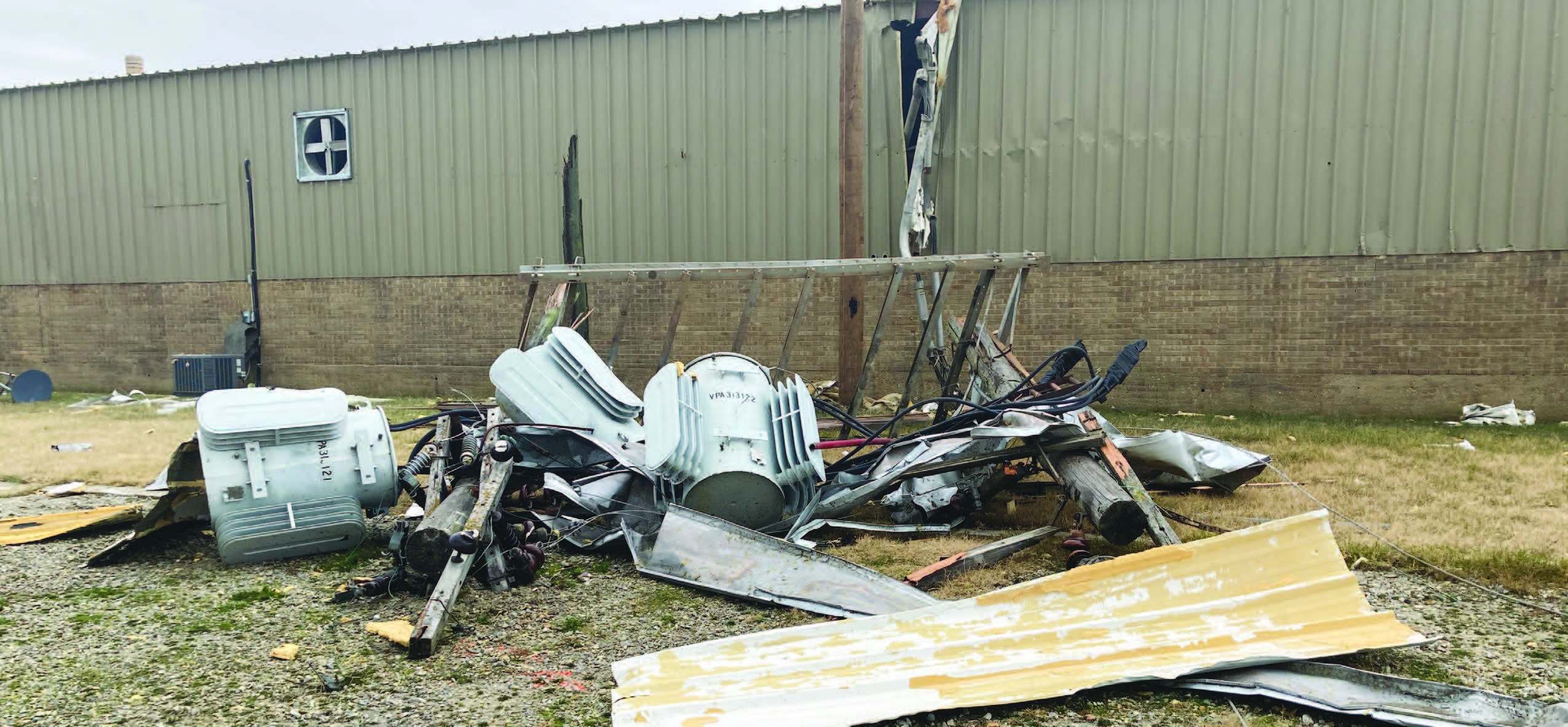
Step 4. Focus on Acquiring Electricity
If electricity cannot be restored quickly (and it probably won’t), you may need access to several generators. You will need enough power to empty chemical tanks and get the office back online to support customers. Thousands of people could be without power, so be aware that you might be at the end of a long line, and it could be some time before your power is restored.
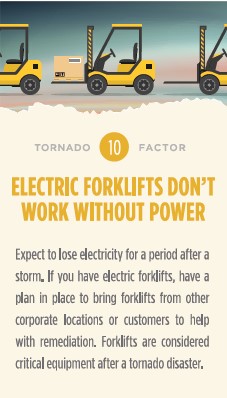
Step 5. Make Daily Conference Calls to Corporate
For at least the first few days (and up to a week) you should expect daily conference calls to update the corporate team on cleanup status. The manager’s role will be to tell those on the call what steps the team took since the last call and what you are planning next to move the project along.
Communication is so important because it is the manager who has the boots on the ground and who knows what is going on. Since the landscape is everchanging, keeping the corporate team up-to-date makes them aware of your needs. As the project moves forward, the resources will change from the initial disaster response, to the recovery phase, and through the completion of construction of the warehouses and buildings.
Step 6. Identify and Rectify Unsafe Areas
After a horrific event like a tornado, certain areas of your facility may be safe to access, while other structures cannot. You will need to clearly identify what is safe and what is not. This may require the professional services of a structural engineer to evaluate all buildings with moderate to severe damage. Parts of a building may have to be torn down, piece-by-piece to access the products stored within.
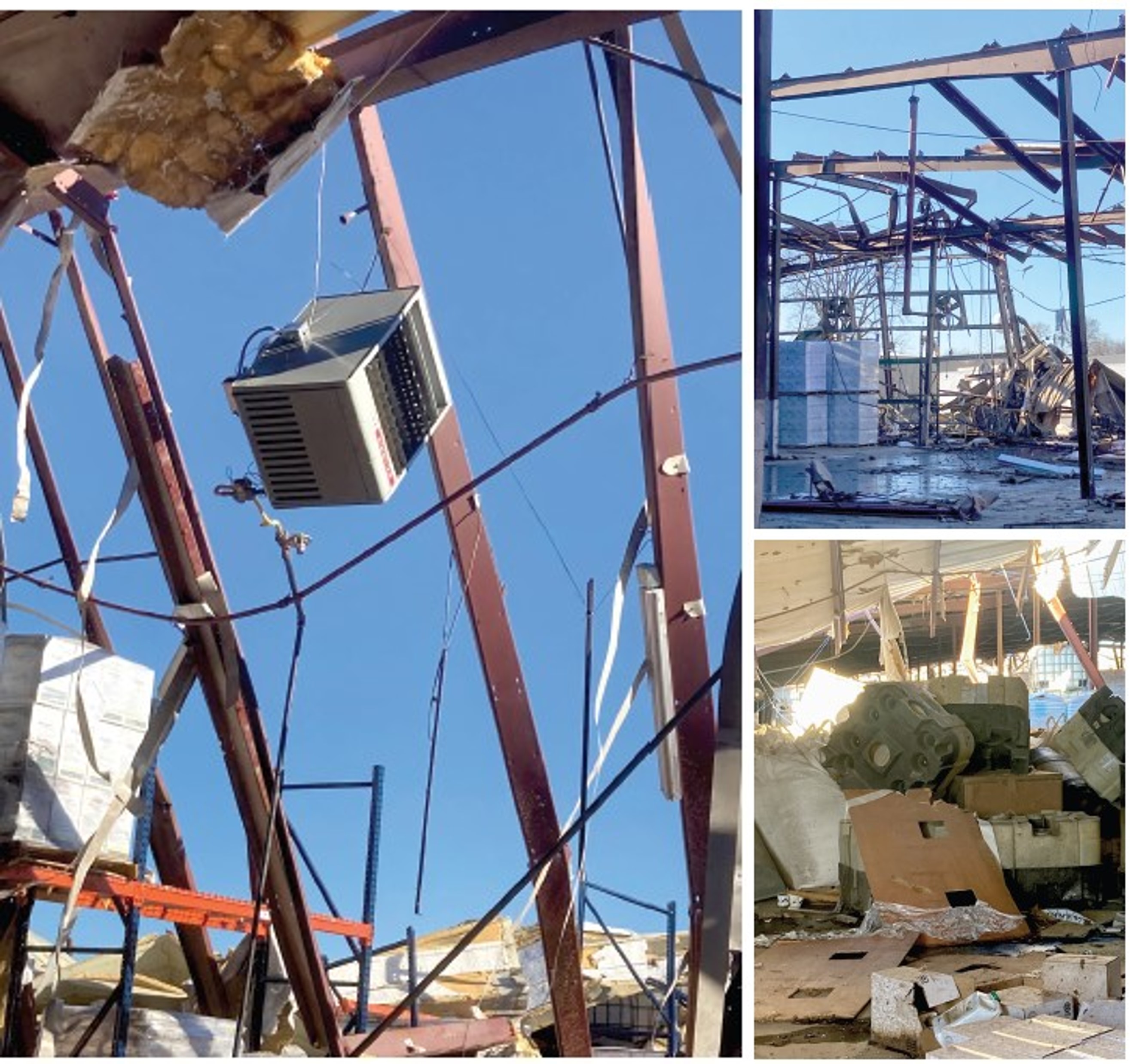
Make sure you identify all locations where safety hazards are present.
Step 7. Hold Daily On-site Briefings with Contractors
Work will proceed along different paths at the same time. It will take considerable coordination between those trying to remediate the facility and those trying to salvage useable products.
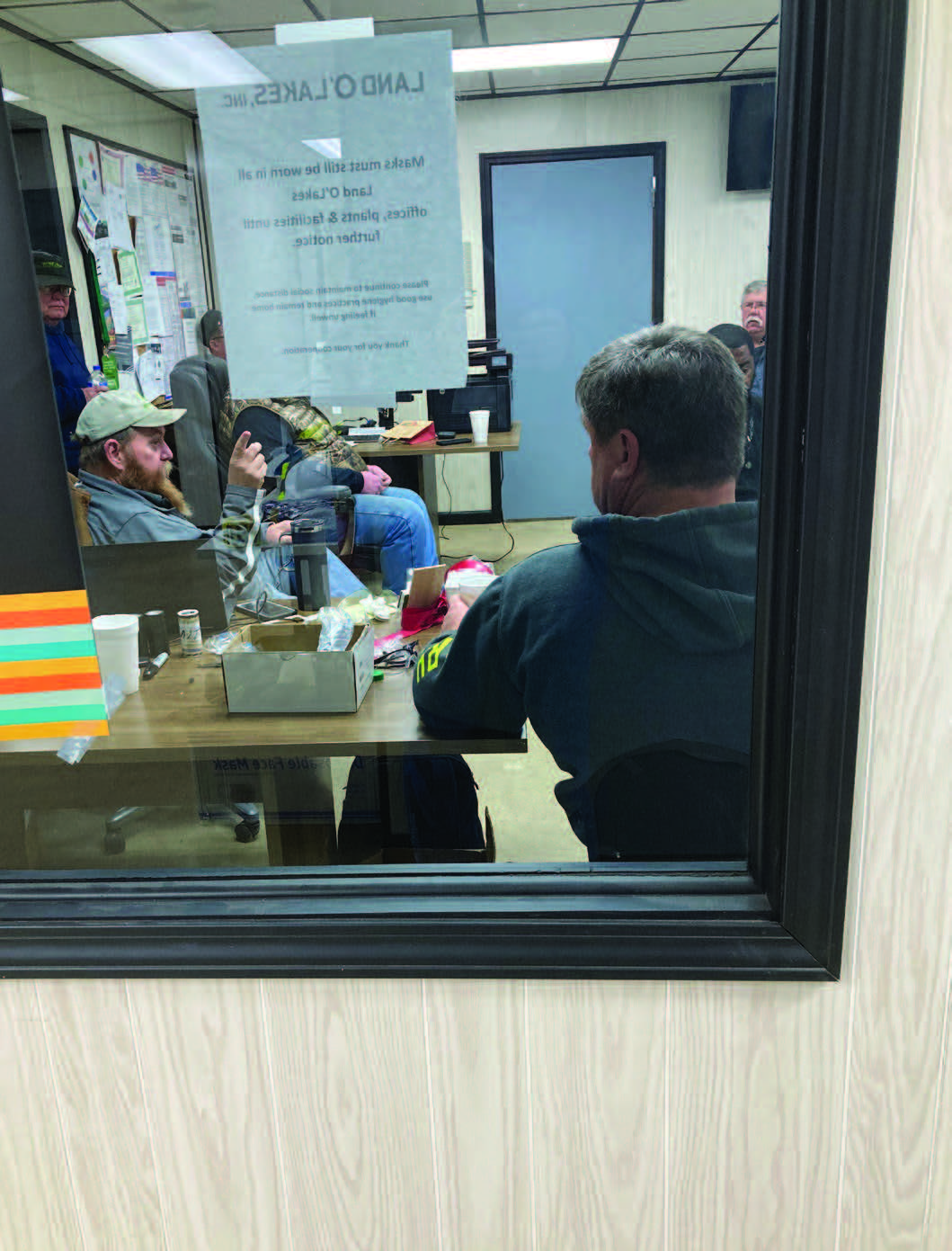
To keep the lines of communication open, it is common to hold a morning planning meeting and an afternoon accomplishment meeting. The morning meetings are especially useful for discussing where each group plans to work that day. This allows the group to be able to make changes to the day’s planned activities to accommodate everyone’s needs. Once again, the manager plays a vital part in the recovery efforts during these briefings. One of the lessons learned from the tragic events of 9/11 was how important a unified command structure is when one person is in charge. In most cases of dealing with a tornado’s aftermath, the manager who knows the facility is in the best position to take charge.
Step 8. Clean the Site of Debris and Chemicals
In the event of a tornado, explosion, or railcar derailment at your facility, you often will call specialized contractors to help stabilize the situation and begin the mitigation of the property. When a disaster strikes, it is often the case that your national contractor has agreements with regional emergency response contractors around the nation who are closer to you and who can bring workers and equipment on-site much quicker.
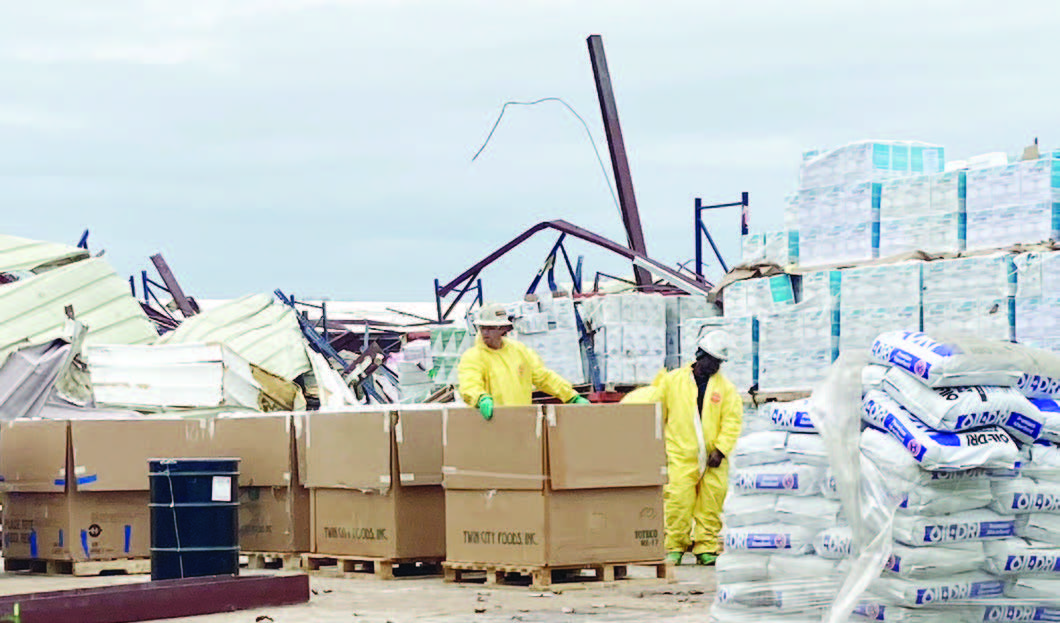
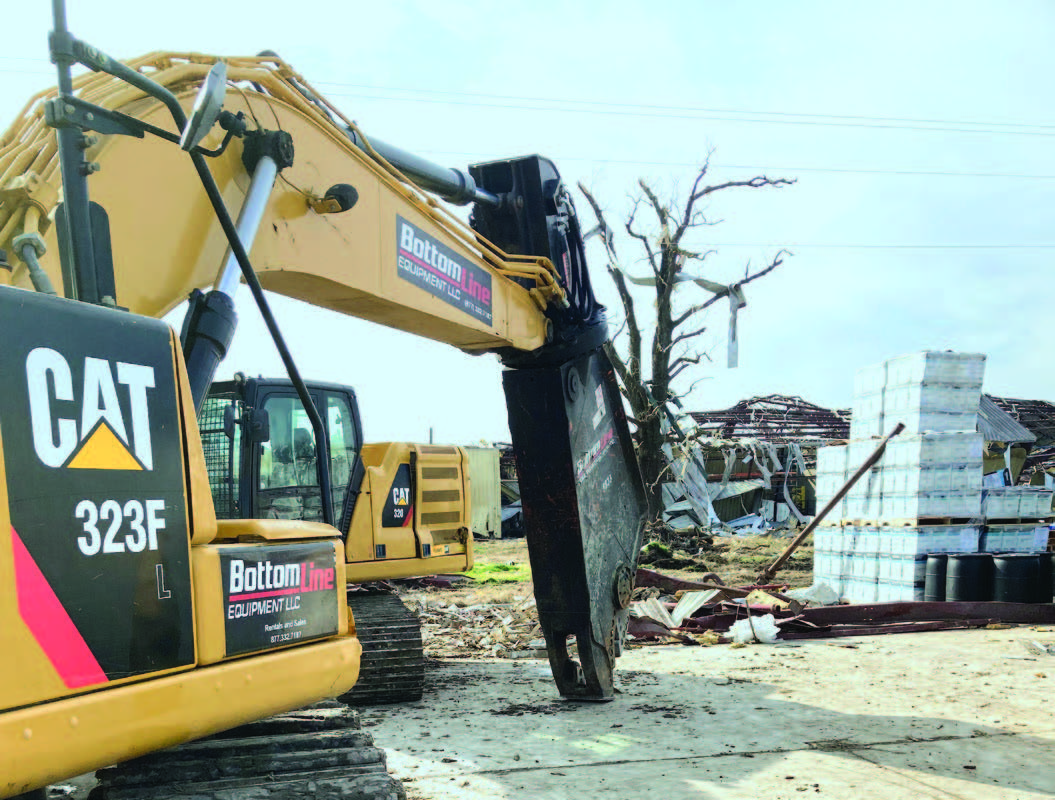
Emergency contractors can provide whatever resources you might need, including:
• Heavy equipment
• Demolition work
• Dirt work
• Structural engineers
• Building construction
• Personnel qualified to handle chemicals
• Large-capacity steel tanks (frac tanks)
• Generators
• Specialized equipment like industrial vacuums, shears, excavators, and long-reach forklifts.
Step 9. Salvage Useable Products
Stored products in bags, jugs, containers, or tanks are always the facility’s responsibility. Recover and account for undamaged products. This serves many purposes, including:
• Creating an inventory
• Calculating how much product was lost
• Determining how much product you need to replace
• Estimating product replacement costs for insurance purposes
• Developing the hazardous waste manifest for transporting and disposing of materials off-site
• Reporting spill information to state and federal agencies
From a logistical standpoint, managers will need to find places where they can aggregate and temporarily store recovered products. Such staging areas should be clean and easily accessible by forklifts that can move products on pallets. If possible, staging areas should be inside to protect the products from rain. Often, you can load products onto trucks that are provided by customers and competitors alike to move the salvaged products to their properties for temporary storage. Much product salvage involves a visual examination by the facility’s employees and contractors. The containers and the boxes holding them must look clean. That is easier with some products, like those that are still surrounded by shrink wrap with no signs of leaking on the boxes. You can remove such items from the building, reposition them at a temporary stage location, and then move them to a separate warehouse on the facility or off-site.
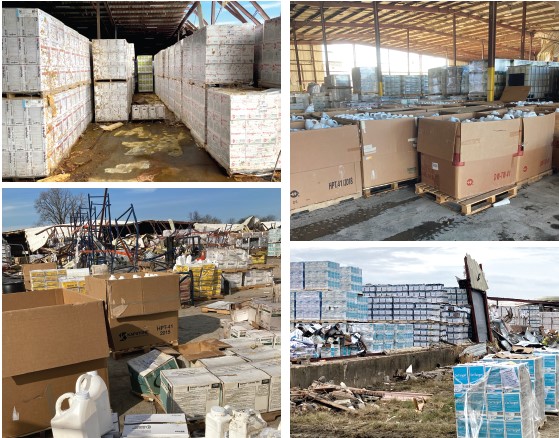
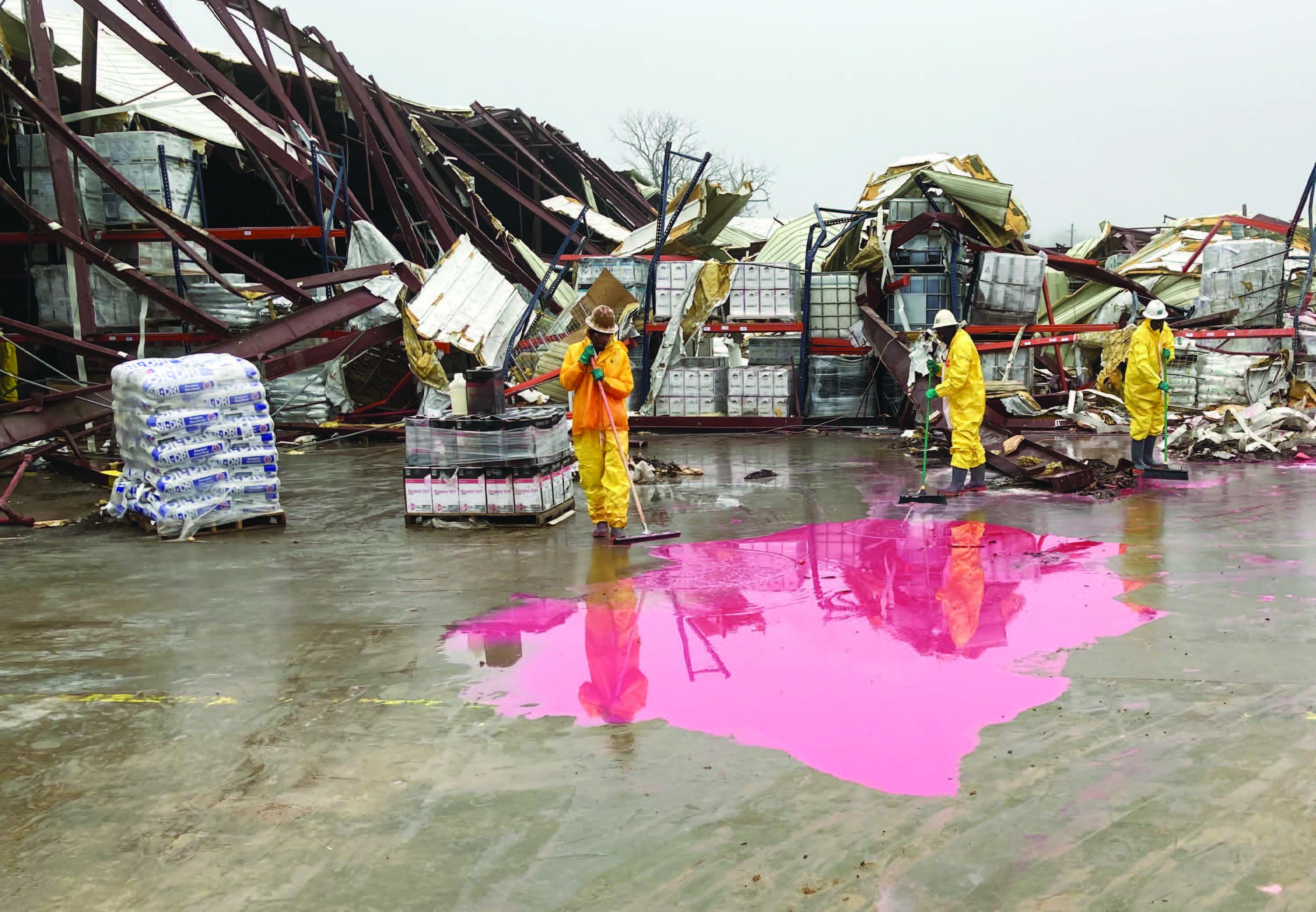
Leave crushed or leaking products in place to allow the contractor’s employees (who are trained to handle hazardous materials) to manually inspect and move them. They also will remove, dismantle, and dispose of boxes and other packaging material. They also will inspect jugs one at a time to determine if they are salvageable. If they are salvageable, they can be repacked and moved to the staging area.
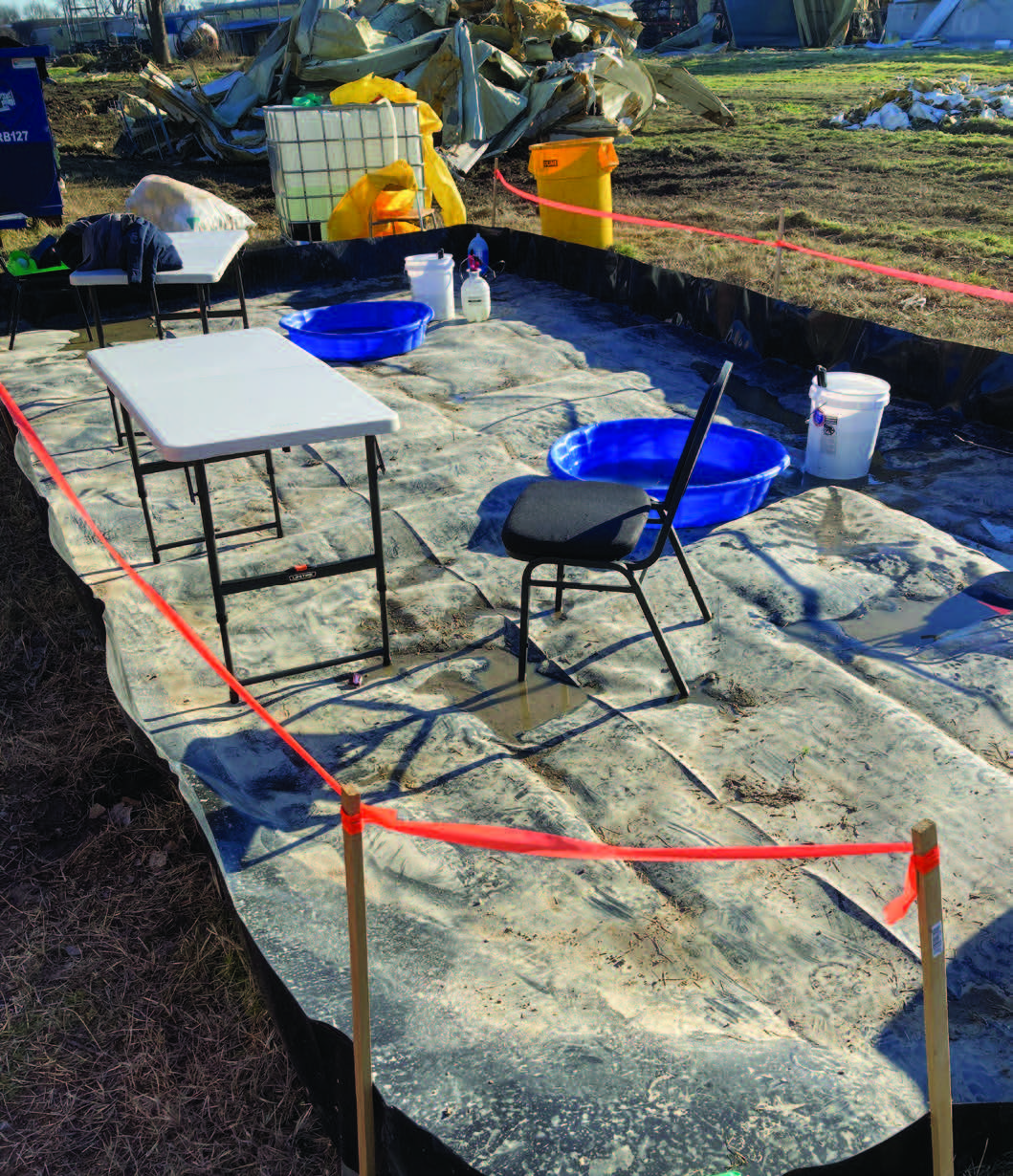
If a container is leaking or damaged, contractors discard the contents into larger minibulks, which can then be pumped into larger metal frac tanks. An EPA-approved waste disposal site will dispose of the mixed contents of the frac tank. As the waste generator, the facility will have to obtain the EPA ID numbers of the materials in the tanks before they ship the materials for off-site disposal.
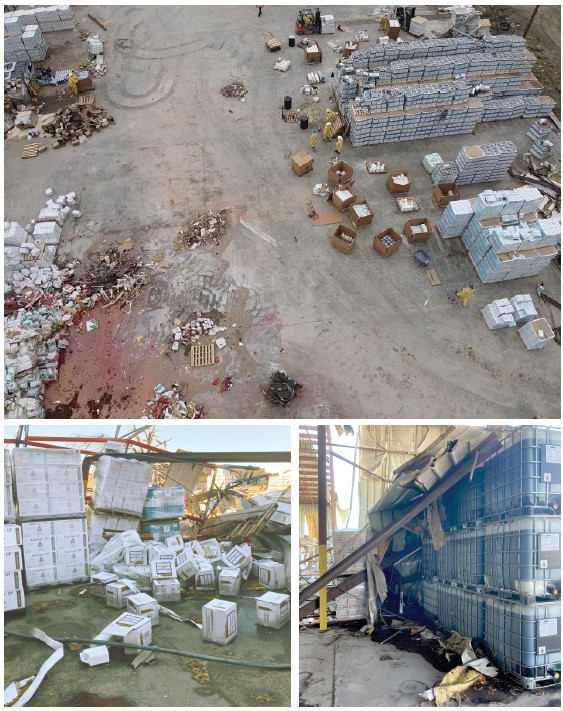
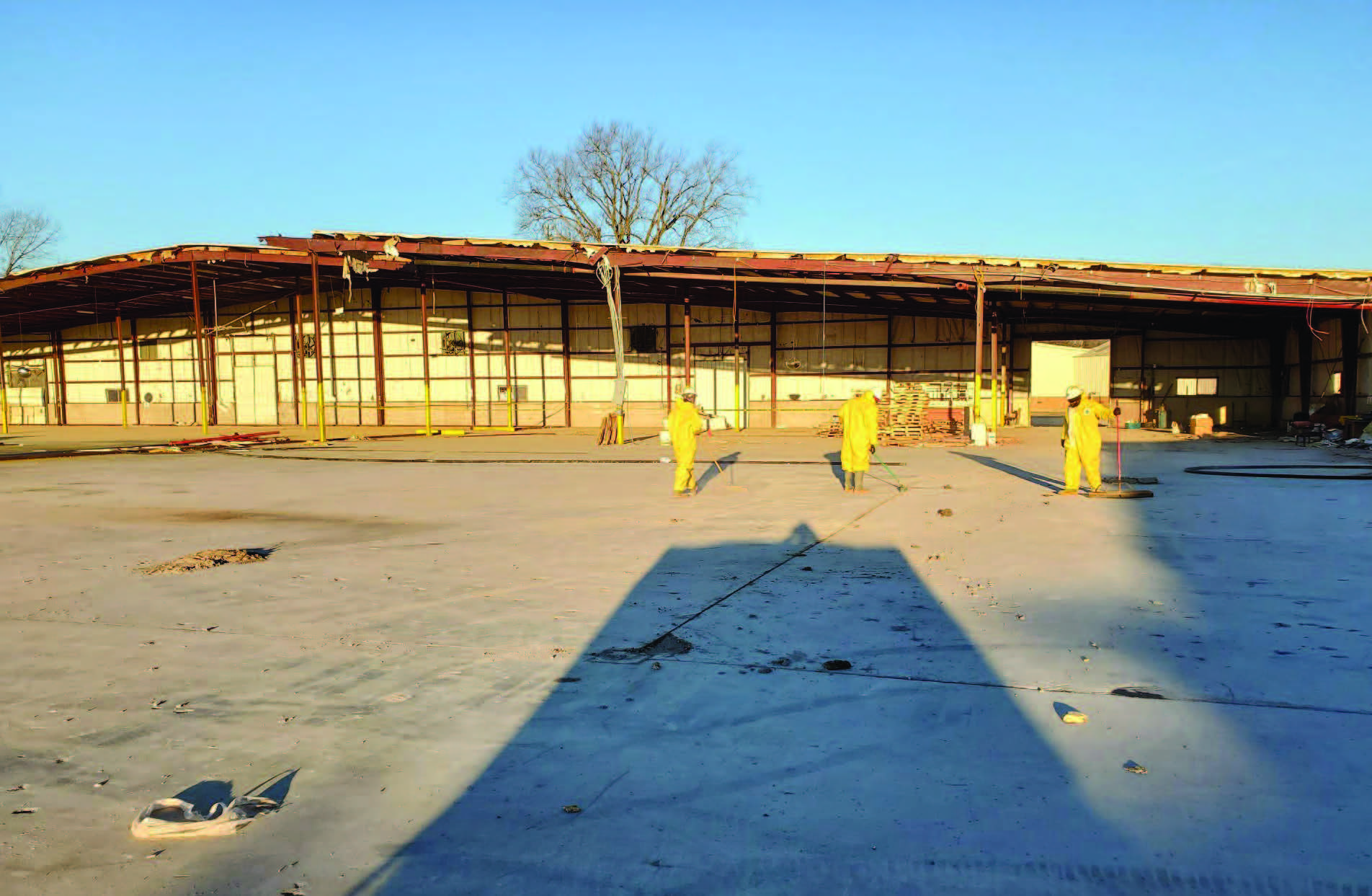
Step 10. Deal with Customers
Even while dealing with the tornado’s aftermath, the plant may still have to provide services to their customers (if able). Ask your customers for a little understanding and let them know your response time might be a little slower than it has been in the past. Being honest and open about your situation serves you best during this difficult time.
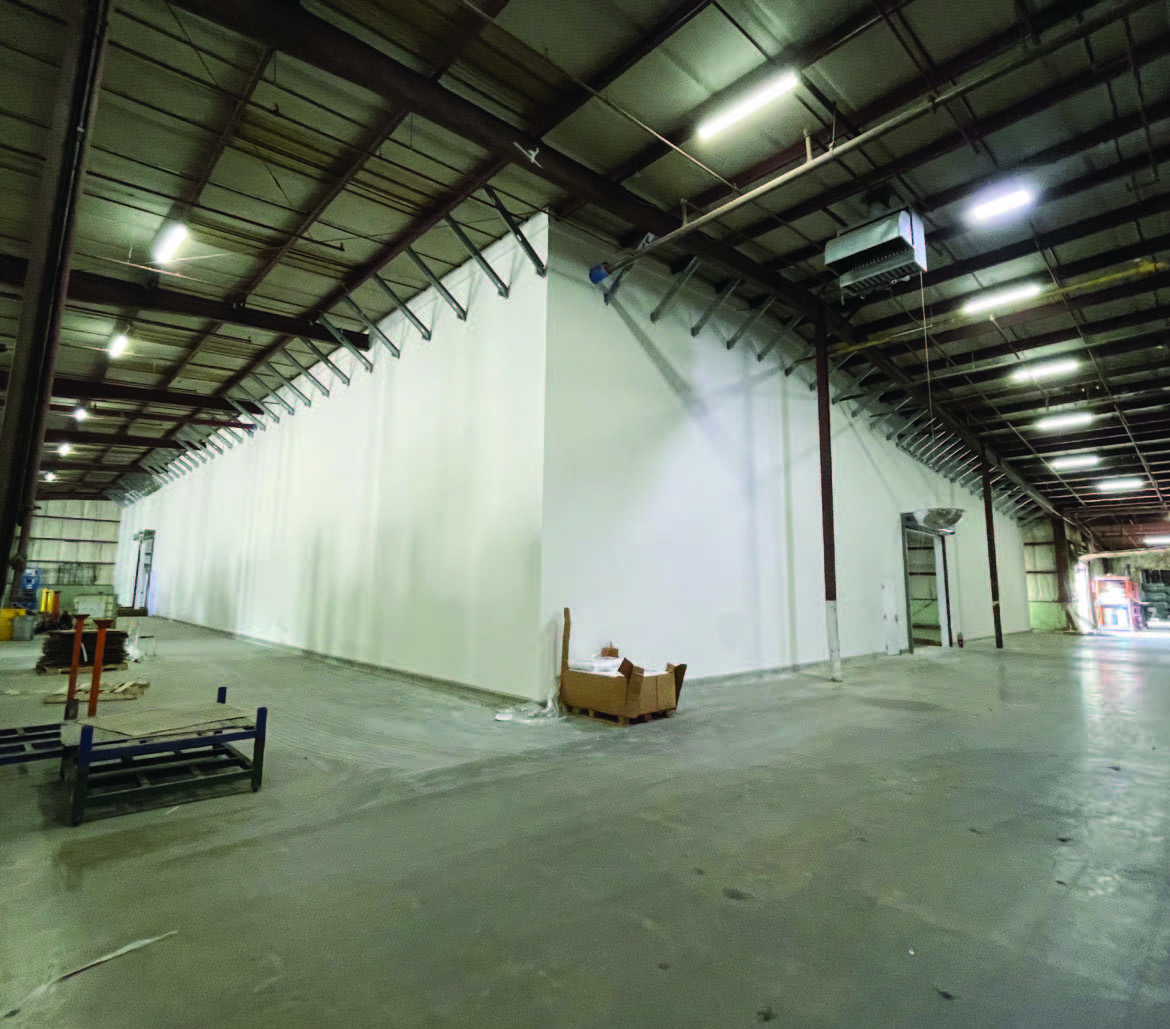
It might be more efficient for the assistant operations manager to communicate with customers rather than be involved with the cleanup. Letting the assistant manager run the business may allow the manager to focus on the remediation and recovery tasks. In some circumstances, the facility may move all their operations to another branch to provide better services to their customers. And as things progress, the manager may have to start pulling key people away from the cleanup to put them back into the field.
Conclusion
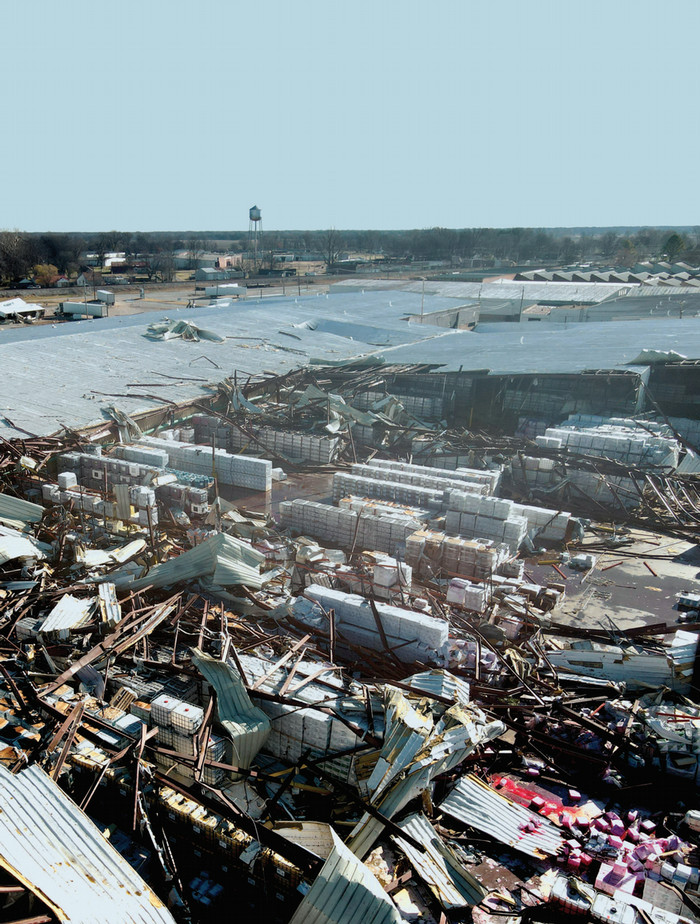
Midwest weather can change quickly —from a light rain shower, to a bad storm with heavy rains and high winds, to a more dangerous situation in a matter of minutes. A tornado can appear from out of nowhere, cut across the landscape, and then disappear back into the sky just as quickly. These very dynamic and unpredictable weather events do not give people much time to prepare. Your quick and decisive actions after authorities issue tornado watches and warnings are key in keeping employees out of harm’s way. It is true that the odds of a tornado striking your facility are rather low, but because tornadoes are an annual, unpredictable threat across the ag belt, facilities must routinely practice tornado preparedness.
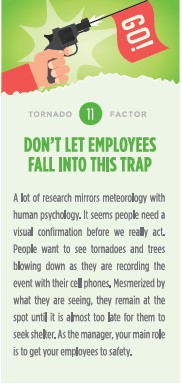
While most tornadoes are weak and short-lived, some can be catastrophic — as the photographs in this publication clearly illustrate. In just a few short minutes, homes, businesses, and communities may be devastated and lives may be lost. The good news is that many of the procedures and processes you will undertake after a tornado are similar to what you would do in any emergency, whether it is wind, flood, fire, chemical spill, or explosion.
Keep people safe, protect the environment as best you can, and implement procedures that safeguard the facility. You should develop the majority of your facility’s planning and response procedures well in advance, when the sun is shining, not when the dark clouds are rolling in and the tornado sirens are blaring all around you. More importantly, take time each year to train your employees (and yourself) about what should be done in the event of a tornado.
At a minimum, be able to answer these questions before disaster strikes:
• What will you do if your buildings or warehouses get hit?
• How will you contact employees away from the plant?
• Should you shelter at the facility or send everyone home?
• Who has assigned responsibilities when a tornado warning is issued?
• Where are the emergency response plans located?
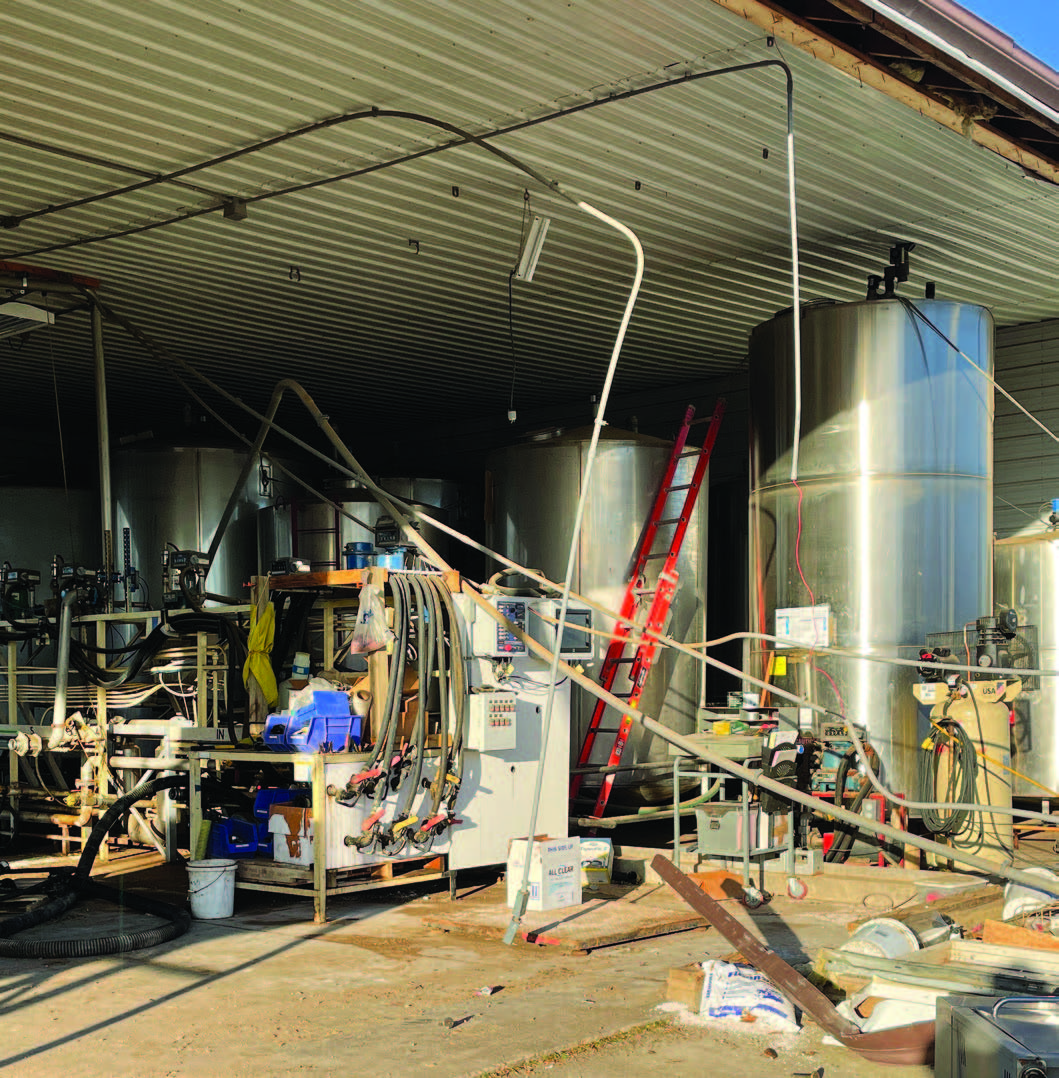
You want everyone at your facility to know the answers to these questions, so the response becomes more-or-less as routine as a fire drill practiced in an elementary school. Retail managers should trust their instincts, know what actions to take, and then proceed to implement them to the best of their abilities. The company’s emergency response action plan should outline those actions for you — just be sure you always have access to the plan.
You should strive to be as absolutely prepared as you can before a disaster hits, or you should at least be prepared enough to make your first moves. Prepare and practice what to do in the event you come face-to-face with a tornado. If you don’t, you are playing the odds and leaving it to chance that, somehow, you will figure out what to do when the time comes. Making sure people are safe and out of harm’s way is always your main priority. You can replace facilities and equipment, but you cannot replace someone’s life.
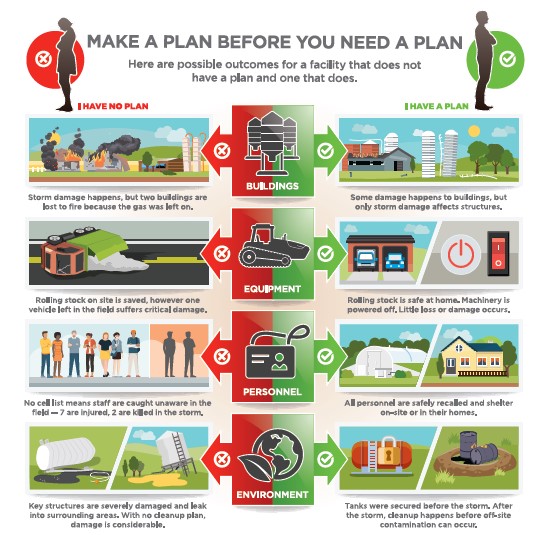
Acknowledgements
Thanks to Dawn Minns for graphic design and Adduci Studios for illustrations. Thanks also to the following individuals who provided valuable comments and suggestions that improved this publication:
Greg Dahl, Winfield United
Bill Davis, Purdue University
Colt Haley, Nutrien
Larry Lenderman, Land O’Lakes
Clint Morris, Nutrien
Hans Schmitz, Purdue University
Adam Shanks, Purdue University
Brad Shelton, Purdue University
Jay Throesch, Land O’Lakes
Find Out More
Purdue Pesticide Programs offer a number of publications on related topics to help you prepare for unexpected emergencies. All publications are available from The Purdue Extension Education Store or Purdue Pesticide Programs. edustore.purdue.edu • ppp.purdue.edu
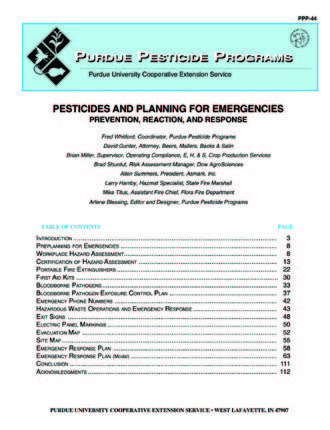 Pesticides and Planning for Emergencies (Purdue Extension publication PPP-44) describes how to develop a proactive emergency plan to reduce the risk of an accident involving pesticide
Pesticides and Planning for Emergencies (Purdue Extension publication PPP-44) describes how to develop a proactive emergency plan to reduce the risk of an accident involving pesticide 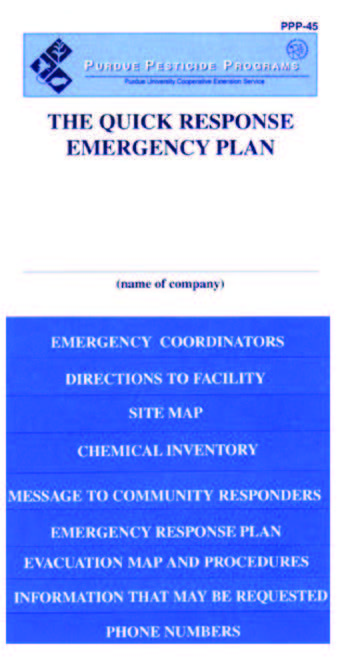 It is important to have all emergency information quickly available when an emergency situation arises. Quick Response Emergency Plan (PPP-45) is a booklet that helps you
to keep this information readily available.
It is important to have all emergency information quickly available when an emergency situation arises. Quick Response Emergency Plan (PPP-45) is a booklet that helps you
to keep this information readily available. 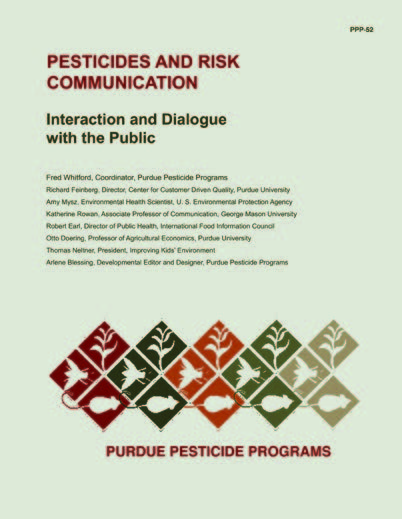 Pesticides and Risk Communication (PPP-52) deals with interaction and dialogue with the public on pesticides and risk communication.
Pesticides and Risk Communication (PPP-52) deals with interaction and dialogue with the public on pesticides and risk communication. 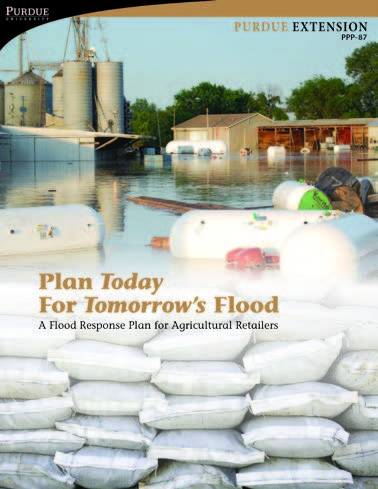 Plan Today For Tomorrow’s Flood (PPP-87) raises the awareness of how floodwaters pose risks to both agricultural retailers and their communities. It also helps retailers examine
what they need to do to create a flood preparation plan.
Plan Today For Tomorrow’s Flood (PPP-87) raises the awareness of how floodwaters pose risks to both agricultural retailers and their communities. It also helps retailers examine
what they need to do to create a flood preparation plan. Disclaimer
This publication is intended for educational purposes only. The authors’ views have not been approved by any government agency, business, or individual and cannot be construed as representing a perspective other than that of the authors. The publication is distributed with the understanding that the authors are not rendering legal or other professional advice to the reader, and that the information contained herein should not be regarded or relied upon as a substitute for professional consultation. The use of the information contained herein constitutes an agreement to hold the authors, companies, or reviewers harmless for liability, damage, or expense incurred as a result of reference to or reliance upon the information provided. Mention of a proprietary product or service does not constitute an endorsement by the authors or their employers. Descriptions of specific situations are included only as hypothetical case studies to assist readers of this publication and are not intended to represent any actual person, business entity, or situation. Reference in this publication to any specific commercial product, process, or service, or the use of any trade, firm, or corporation name is for general informational purposes only and does not constitute an endorsement, recommendation, or certification of any kind by Purdue University. Individuals using such products assume responsibility that the product is used in a way intended by the manufacturer and
misuse is neither endorsed nor condoned by the authors nor the manufacturer.
Reference in this publication to any specific commercial product, process, or service, or the use of any trade, firm, or corporation name is for general informational purposes only and does not constitute an endorsement, recommendation, or certification of any kind by Purdue Extension. Individuals using such products assume responsibility for their use in accordance with current directions of the manufacturer.
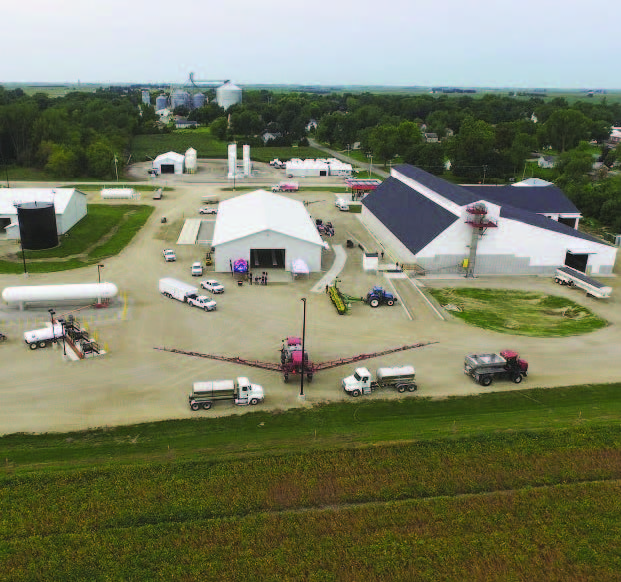
Find out more at
THE EDUCATION STORE
edustore.purdue.edu
